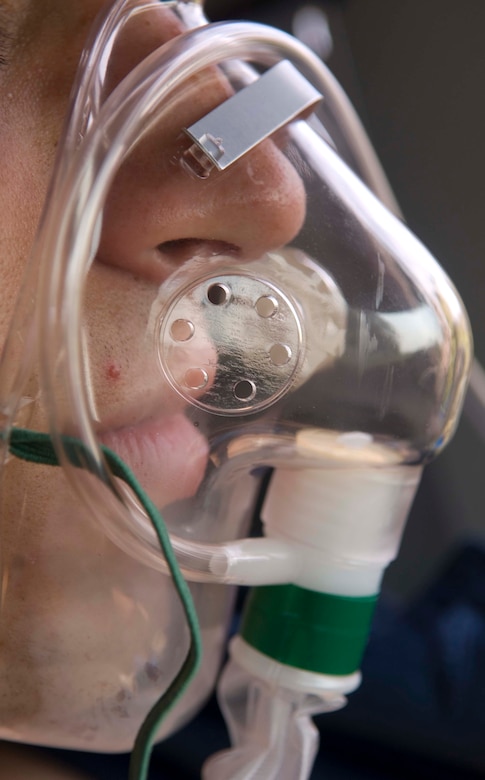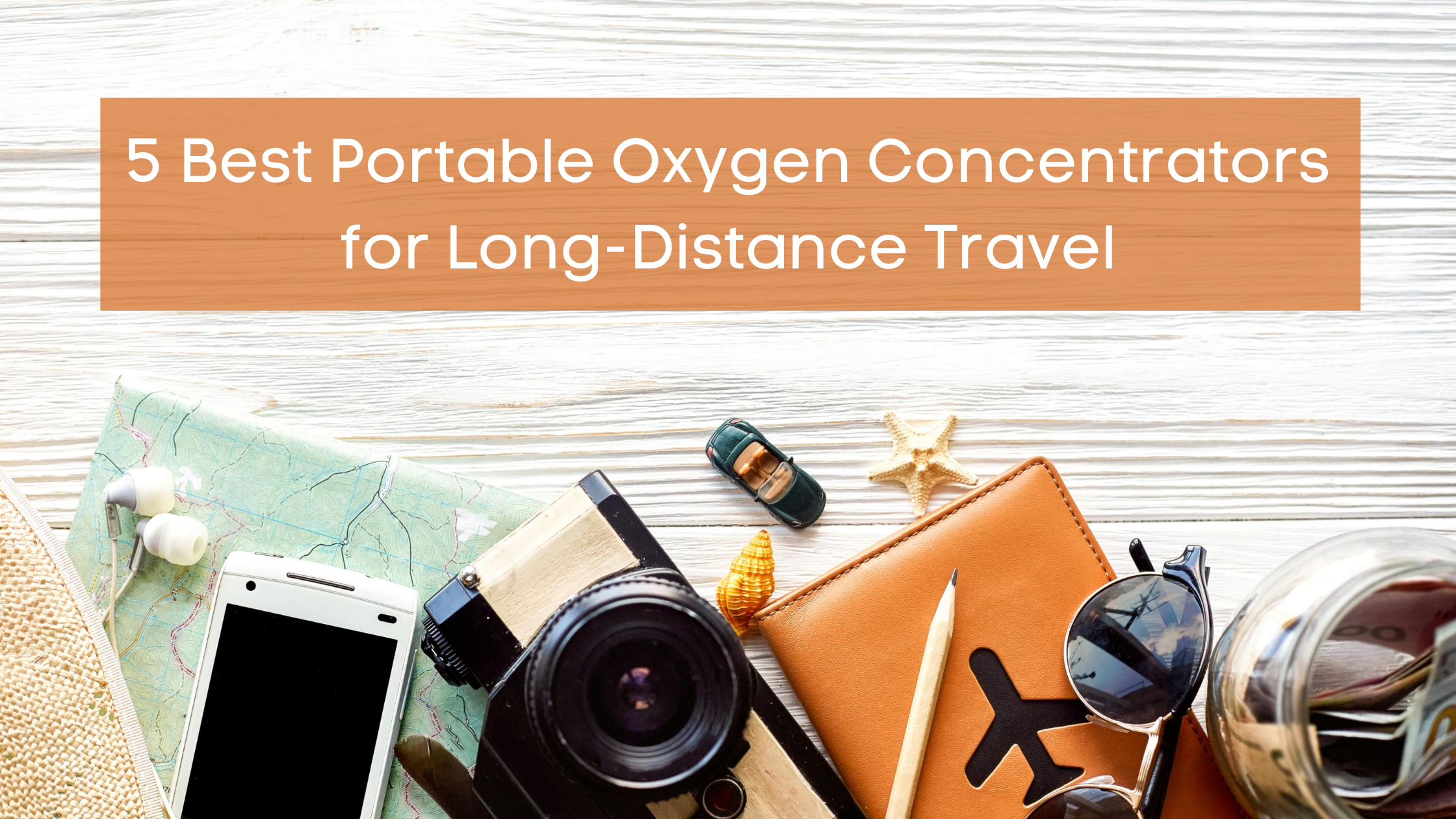
Most chronic respiratory conditions are considered “debilitating.” What this means is that they have a tendency to make the patient weak and physically incapable of certain tasks like rigorous exercise. Chronic obstructive pulmonary disease (COPD) is one such condition because it prevents carbon dioxide-rich air from escaping the lungs upon expiration. This results in frequent breathlessness, chest pain, fatigue, and more.
Another reason COPD could be considered a debilitating disease is that it often requires patients to be hooked up to an oxygen machine for a significant portion of the day. People with stage 1 or 2 COPD may only need to use supplemental oxygen for several hours a day, whereas someone with stage 3 or 4 COPD may need to be hooked up to an oxygen device 24/7.
From an outside perspective, this may seem a little daunting. After all, how could you expect to live a normal and full life if you’re expected to be connected to an oxygen device constantly? While this could be the “end of the line” so-to-speak for many other conditions, this is not the case for COPD patients. Fortunately, many years of research have gone into supplemental oxygen therapy and manufacturers are able to offer smaller, lighter, and more portable oxygen delivery machines than ever before.
In 2020, the gold standard in medical oxygen therapy are portable oxygen concentrators. Like the stationary oxygen concentrators which came before them, these are electronic devices. The primary difference, however, is that they run off batteries rather than a wall outlet, meaning you can take them wherever you want. If you’re a COPD patient who’s caught the travel bug, read on as we take a look at the top 5 portable oxygen concentrators for long-distance travel.
If you have any questions at all about any of the units, either follow the link to each product page or reach out to our respiratory specialists who can help you find the concentrator that’s right for you.
The Caire FreeStyle Comfort
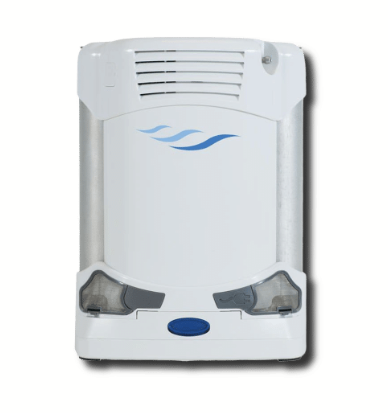
There really isn’t a whole lot to say about the Caire FreeStyle Comfort that hasn’t already been said. However, we don’t mind repeating ourselves if it means getting the word out to more people about how great of a device this is. Simply put, the FreeStyle Comfort is one of the best portable oxygen concentrators that money can buy as of 2020 and this rings especially true for people who are interested in long-distance travel.
Outstanding Durability
For many people, the most stressful thing about going on a long-distance trip is the thought of losing or breaking something that’s valuable to them. For example, if you break your phone, you might spend half your vacation getting it fixed rather than enjoying your time away from home. Or worse yet, you may find yourself in a situation where you aren’t able to get it fixed. This is why it’s so important to invest in durable and reliable equipment that won’t stop working when you need it most.

You may be surprised to know that the Caire FreeStyle Comfort is the one and only portable oxygen concentrator that’s used by the United States armed forces; in other words, it’s the only true “military-grade” portable oxygen concentrator. And while we certainly don’t expect you to be going to boot camp anytime soon, this is most definitely a testament to the quality design that Caire uses on their product.
With the FreeStyle Comfort, you’ll never have to worry about damaging your unit if you happen to bump into something or drop it on accident. While there are a lot of delicate electronic components inside the FreeStyle Comfort, they’re all protected by a solid outer shell. Be aware, however, that this portable oxygen concentrator (along with most other POCs) is not waterproof. The carrying case will help protect it from water a little bit, but it is not water-resistant, so be sure to take care when using it outside.
{{cta('43b79c5e-6bd6-4f02-ac27-2d038d20c146')}}
The Inogen One G5
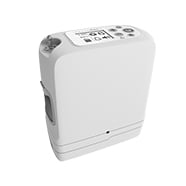
Inogen is one of the top companies in the industry when it comes to pulse dose portable oxygen concentrators. Since their inception, they’ve worked tirelessly to make portable oxygen units lighter, smaller, and more powerful than ever before. Releasing just last year, the Inogen One G5 proved that it’s possible to have a high flow of medical-grade oxygen wherever you go.
High Oxygen Output
Oxygen output is a crucial factor to consider when buying a new portable oxygen concentrator. When your doctor or pulmonologist prescribes you oxygen, he/she will give provide you with an exact volume of oxygen that you need per minute. Pulse dose machines like the Inogen One G5 are measured in milliliters per minute (ml/min). And the G5 has the highest oxygen output of any pulse dose concentrator on the market. Its maximum oxygen output is 1,260 ml/min and a pulse flow setting of 6. That’s about 210 ml/min for each flow setting.
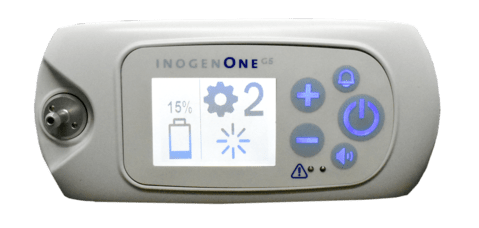
Simply put, a high flow of oxygen means that more people will be able to experience the freedom of owning a lightweight portable oxygen concentrator. And if you’re someone who uses a lower flow setting like a 2 or a 3, you’ll be happy to know that you have some breathing room if you should need to move up for one reason or another. For example, if you check your blood oxygen level using a pulse oximeter and it’s lower than expected, you can simply press a button on the G5 and receive an additional 210 ml/min of oxygen.
{{cta('fa8abc2a-1e88-4fa3-82fd-1cb5b9ed43b2','justifycenter')}}
Possibly the best part about the Inogen One G5’s high oxygen output is that it doesn’t come at the expense of other features. For example, the G5 puts out 1,260 ml/min of oxygen compared to the Caire FreeStyle Comfort’s 1,050 ml/min of oxygen. Despite that fact, the G5 weighs 0.3 pounds less than the FreeStyle Comfort at just 4.7 pounds with the 8-cell battery. It also doesn’t compromise when it comes to battery life. On a pulse flow setting of 2, the G5 offers up to 5 hours of battery life with the 8-cell battery and 10 hours of battery life with the 16-cell battery. Compare this to the FreeStyle Comfort which offers 4 hours with the 8-cell battery and 8 hours with the 16-cell battery.
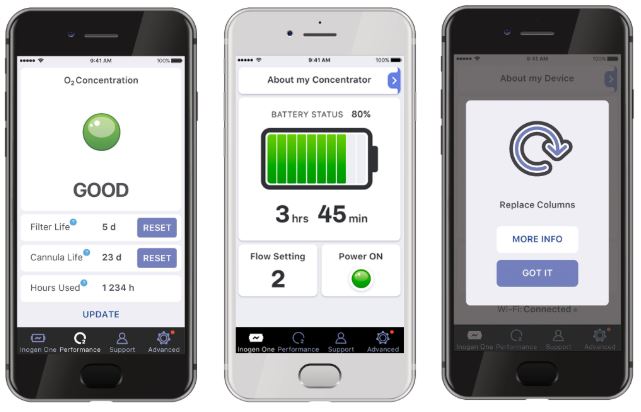
Another great benefit of the G5 is something called the Inogen Connect. This is a smartphone application that connects to your POC through Bluetooth. Once the devices are paired, you’ll be able to view information about your flow setting, remaining battery life, and more. You can even view the device manual if you end up needing to troubleshoot it. This app is especially useful if you’re using the Inogen One G5 backpack and you don’t want to stop constantly to check your G5. Simply pull out your phone and adjust the settings that way.
The Inogen One G3
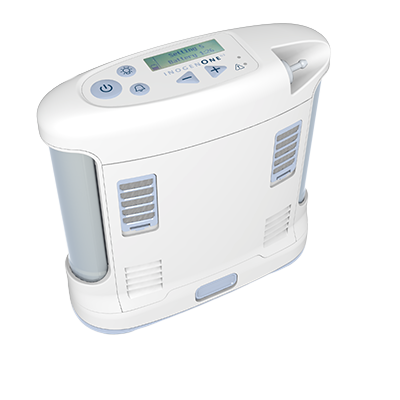
While the Inogen One G3 came out quite a few years ago, it still holds up in 2020 as one of the top pulse dose portable oxygen devices on the market. The G3 is a slight downgrade from the G5 in terms of size and oxygen output, however, it more than makes up for this with an array of high-quality accessories that allow you to customize your supplemental oxygen therapy.
Options to Suit Your Lifestyle
One of the best things about owning an Inogen One G3 is that you don’t just have to settle with what you get right out of the box. There are plenty of accessories that you can use to make your supplemental oxygen more tailored to your preferences. For example, if you’re getting ready to travel long distance, you might choose to upgrade the carrying case that comes with the G3 to something like the Inogen One G3 backpack which will allow you to carry your G3 on your back instead of at your side. What’s more, you’ll have lots of extra space in the bag for personal belongings like your keys, wallet, or passport.
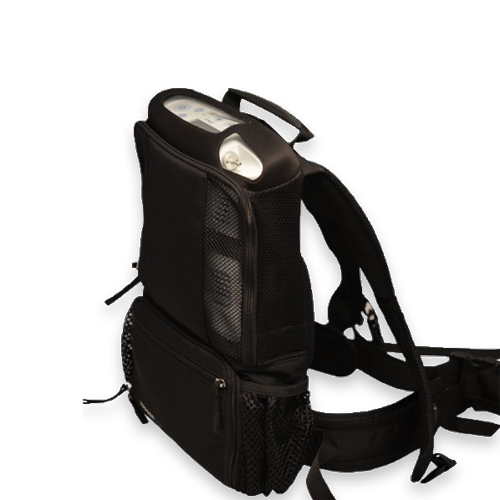
Another similar option to the G3 backpack is the Inogen One G3 Rolling Backpack. This has shoulder straps just like the other one but it also has wheels and an extendable handle so you can pull it around like a suitcase. This is ideal if you’re going to be traveling by plane and you’re bringing a lot of other accessories such as an additional battery, external battery charger, or additional charging cables.
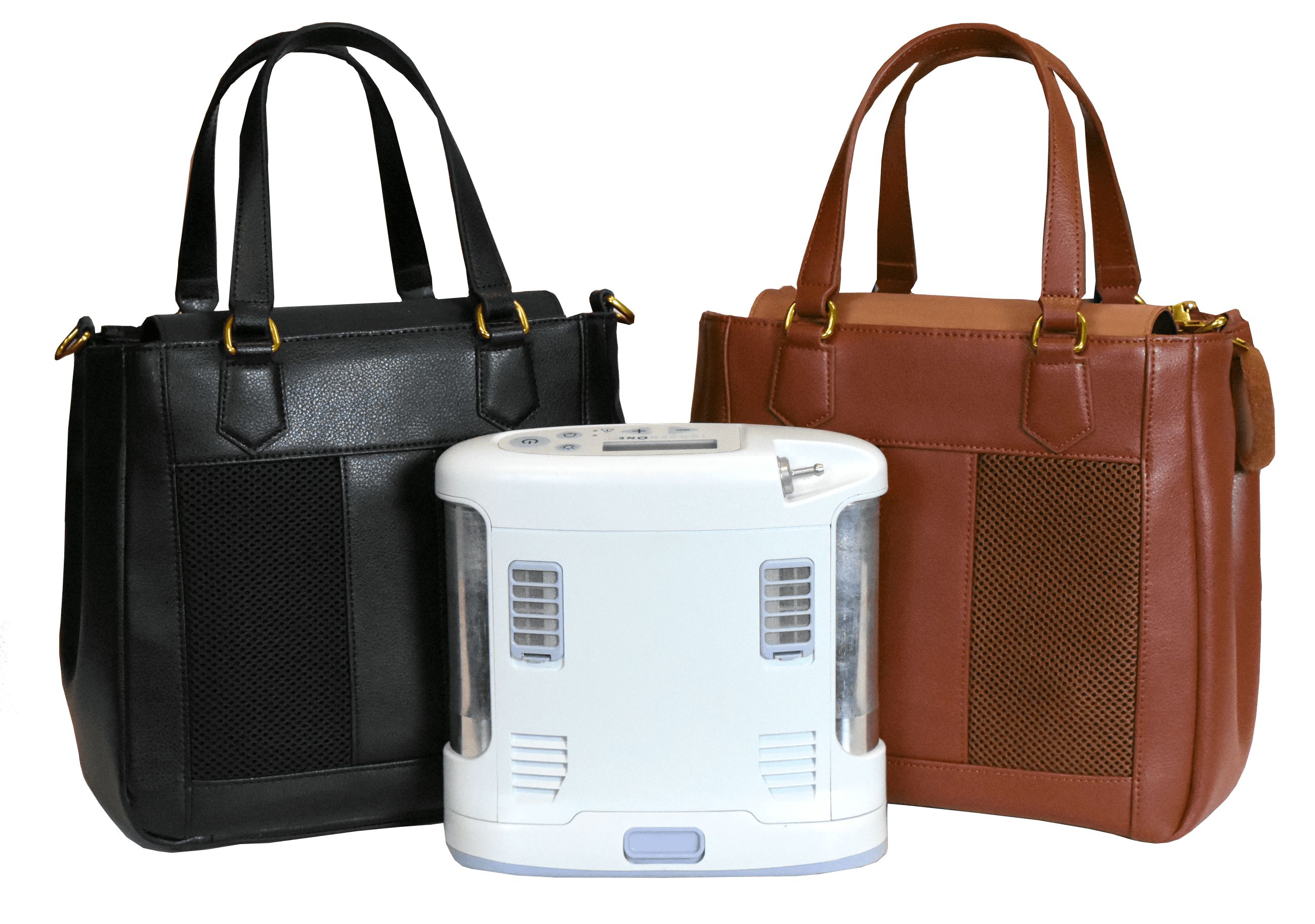
Last but not least, the GO2 Carryalls are another carrying option available to G3 owners. Unlike the backpacks which are designed to provide users with more convenience and carrying space, the GO2 Carryalls provide a more stylish carrying bag for the G3. At first glance, they look like an ordinary purse or handbag, but upon closer inspection, you’ll notice that they are precisely designed for the G3. The user interface is easily accessible via the top zipper, the sides are made of mesh material so that the devices air intake vents aren’t blocked, and there are several extra pockets where you can store personal items.
The Inogen One G4
If you’re someone with early-stage COPD, you’re likely not going to need a huge amount of oxygen throughout the day. If this is the case, you’re probably not going to want to lug around a large POC if it’s not absolutely needed. If this sounds like you then the Inogen One G4 might be right up your alley.

The Inogen One G4 weighs in at just 2.8 pounds making it the second lightest portable oxygen concentrator ever made, behind the AirSep Focus. The G4 goes up to a flow setting of 3 with a maximum oxygen output of 630 ml/min. This is exactly half of what the Inogen One G5 offers.
The Respironics SimplyGo
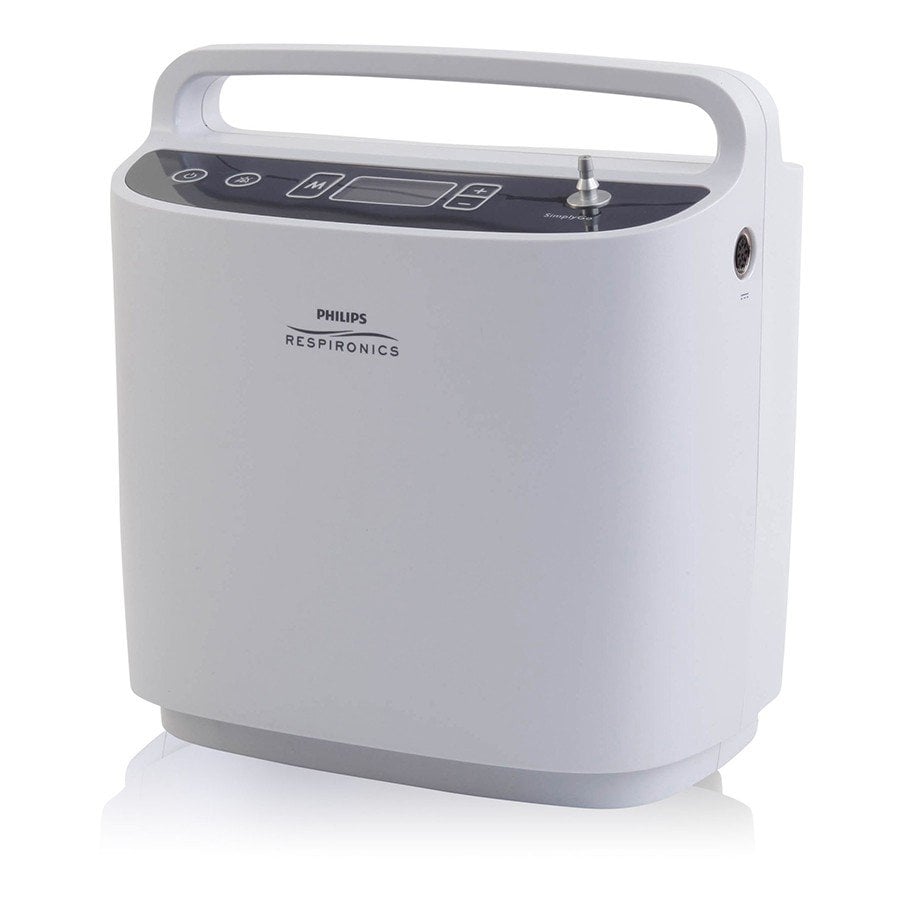
The one thing that all of the above machines have in common is that they’re all pulse flow portable oxygen concentrators. These POCs tend to be much smaller and lighter than continuous flow oxygen concentrators, making them ideal for long-distance travel. However, there is one continuous flow portable oxygen concentrator that we’d recommend for travel — the Respironics SimplyGo.
The reason we’d recommend this over other continuous flow units is because it’s far lighter and smaller than other options out there. For example, the SimplyGo weighs only 10 pounds, but other popular continuous flow units like the Oxlife Independence weigh in at 19.4 pounds. This is nearly twice the weight and it doesn’t have much to compensate for it when it comes to oxygen output or battery life either.
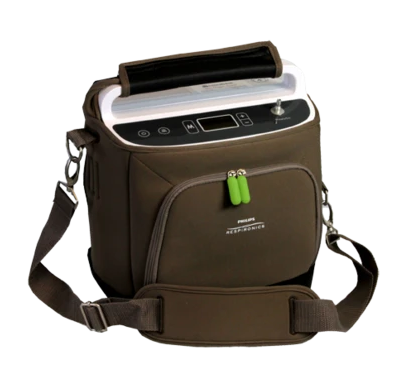
The SimplyGo is one of the few continuous flow machines that can be carried on your shoulder and you’ll find it easy and convenient to take on a flight, cruise ship, or whatever mode of transportation you choose. Since the SimplyGo offers both continuous and pulse flow settings, you’ll have more options for how you’d like to receive your supplemental oxygen on the go.
{{cta('b59df0c1-c4de-47a8-8e1c-0d33d4b414aa','justifycenter')}}
One more benefit of taking a continuous flow portable oxygen concentrator with you on a long trip is that it’s compatible with CPAP and BiPAP machines. So if you suffer from obstructive sleep apnea (OSA) or any other sleep disorder, you’ll be able to attach your SimplyGo and get a better night’s sleep while you’re away from home.
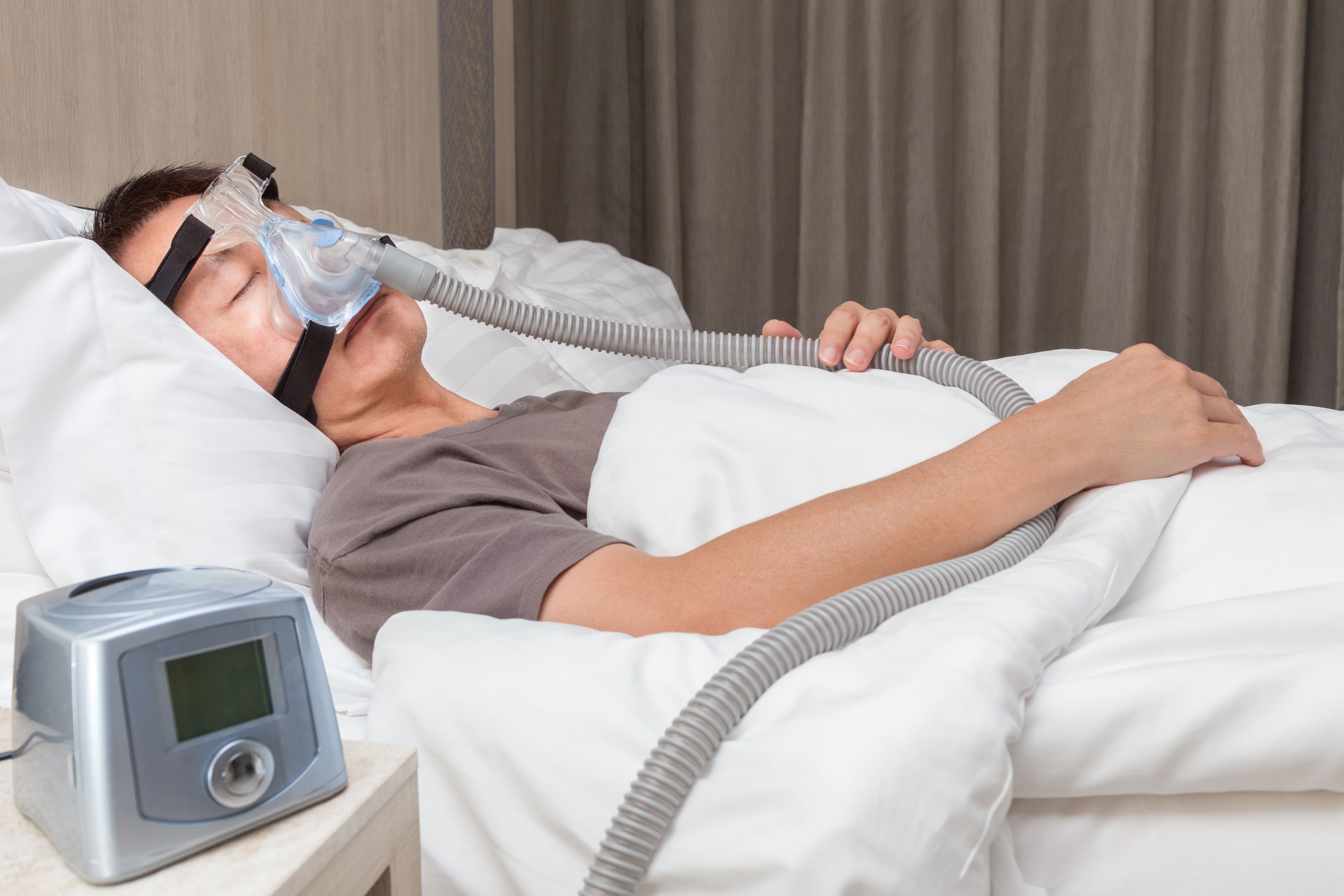
Are Portable Oxygen Cylinders an Option?
Now that you know about some of the best portable oxygen concentrators for long-distance travel, you might be wondering what’s wrong with portable oxygen cylinders. These are the small oxygen tanks that you’ve likely seen people carrying around on their backs or wheeling around with a carrying cart. While these can be convenient in some cases, they’re a very poor choice for long-distance travel.
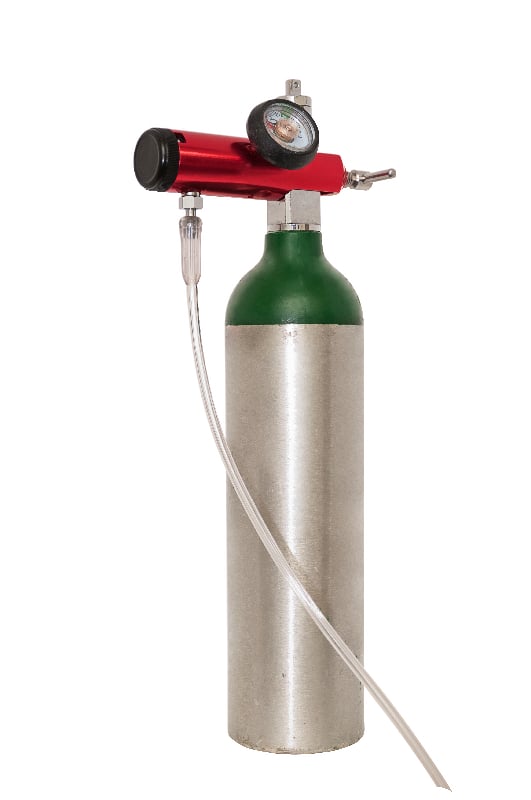
Firstly, they are not approved by the Federal Aviation Administration (FAA) for in-flight use. What this means is that — no matter what airline you choose — you will not be able to fly with an oxygen tank. You’ll either have to approve with your doctor first that you’re able to travel without oxygen or find another way to travel which can be difficult and time-consuming.
Tips for Flying with Portable Oxygen
.png)
Conclusion
We live in unprecedented times for oxygen patients. In the past, being diagnosed with COPD, pulmonary fibrosis, or other chronic respiratory conditions meant giving up your basic freedoms. However, in this day and age, it’s possible for oxygen patients to experience significant freedom by investing in a portable oxygen device that matches their lifestyle.
There are plenty of great options available to you, but you may be having trouble narrowing down your choices. When you’re ready, give our respiratory specialists here at LPT Medical a call and we’ll walk you through the whole process.
-1.png)
Oxygen is essential for maintaining human life. Each time you inhale, your lungs begin a chemical process called cellular respiration where oxygen is removed from the air and is used to convert nutrients into energy that our bodies can use. Without oxygen in the atmosphere, our bodies would have no way to process and digest the food we eat.
However, what many people don’t realize is that oxygen is not always beneficial to the body. Earth’s atmosphere is made up of a variety of gases including nitrogen, argon, and carbon dioxide. Only about 21 percent of the atmosphere is oxygen, so it’s not just the presence of oxygen that makes human life possible, but the fact that there’s a perfect balance of oxygen to keep us healthy.
When the partial pressure of O2 that you inhale is above 0.45 ATA (atmospheres absolute) you’ll start to experience symptoms of oxygen toxicity. Extended exposure to this level of oxygen can lead to pulmonary oxygen toxicity which is characterized by chest pain, shortness of breath, and a chronic cough. Short-term exposure to even higher partial pressures of oxygen can lead to oxygen toxicity of the brain which causes lightheadedness, nausea, and confusion.
In short, your body is designed to process a certain amount of oxygen at a specific partial pressure. When these needs aren’t met, you may begin to experience adverse side effects. These side-effects can be treated with oxygen therapy. In this post, we’ll take a look at 4 different types of oxygen therapy in use today and how they work.
{{cta('fa8abc2a-1e88-4fa3-82fd-1cb5b9ed43b2','justifycenter')}}
Hyperbaric Oxygen Therapy
The term “hyperbaric” is used to describe a gas at a higher partial pressure than it’s normally found at. Therefore, “hyperbaric oxygen therapy” is the use of higher partial pressure of oxygen in order to treat a variety of conditions. One of the most common conditions treated by hyperbaric oxygen therapy is decompression sickness, commonly experienced by scuba divers and other people who breathe with the help of an oxygen tank.
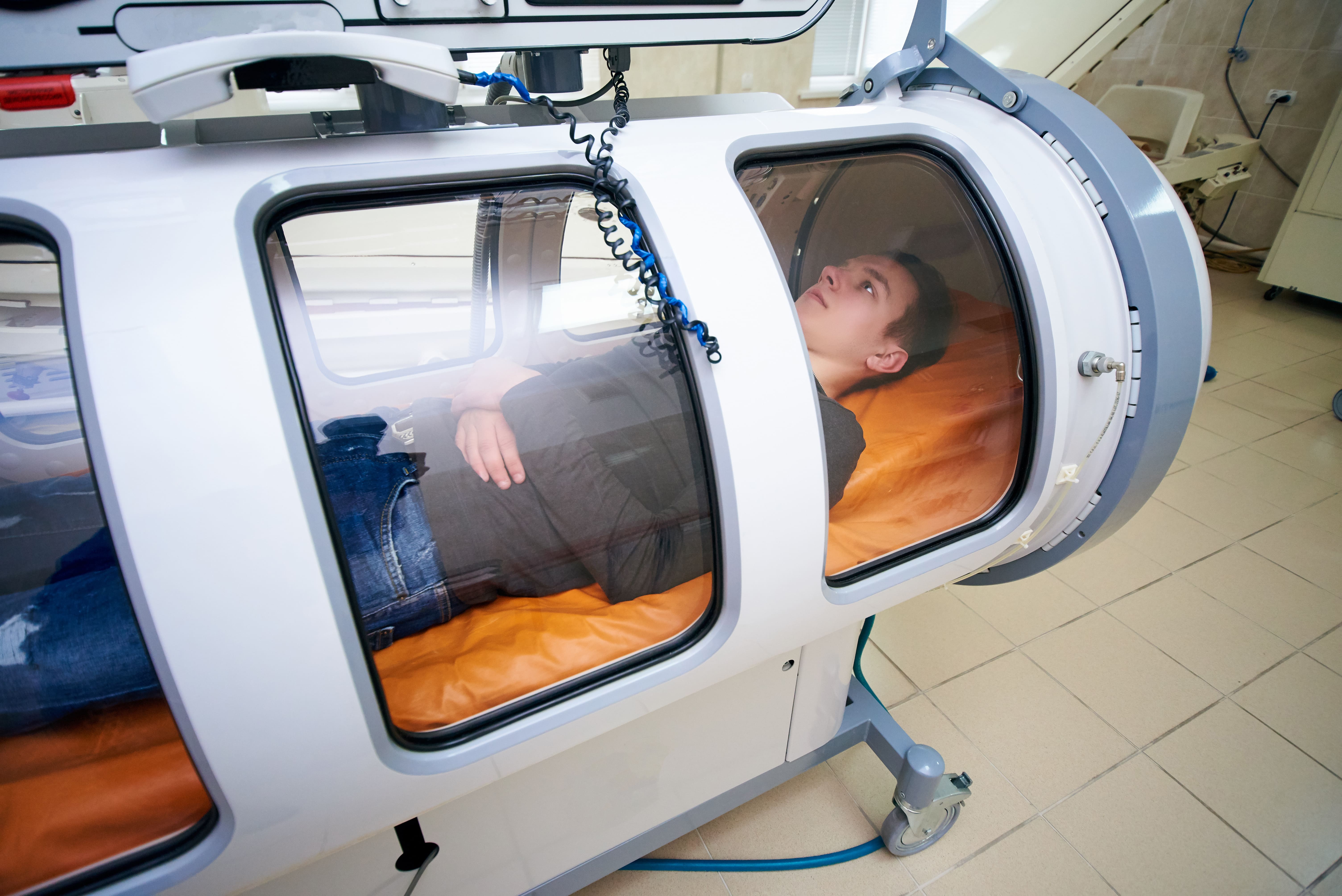
The ultimate goal of hyperbaric oxygen therapy is to get more oxygen in the blood. By inhaling pure oxygen at pressures 1.5 to 3 times higher than normal, it can promote healing in areas of the body that are deprived of oxygen. As such, it can be a useful therapy for treating wounds and infections that are not healing normally. Risks of hyperbaric oxygen therapy include oxygen toxicity, ear trauma, and eye damage.
How Does the Procedure Work?
There are two common types of hyperbaric oxygen therapy (HBOT): monoplace chambers and multiplace chambers. Monoplace chambers resemble MRI machines and they’re able to hold one person. Once the patient enters the chamber, the doors are sealed and it’s slowly pressurized with 100 percent oxygen. The patient is typically required to lie down in order to use a monoplace hyperbaric chamber.
Multiplace chambers perform the same function as monoplace chambers but they are able to treat multiple patients at one time. Once the patients enter the room, they wear a mask that delivers the oxygen and the room is then pressurized. One of the key benefits of this type of hyperbaric oxygen therapy is that the patients have more space and the room is often climate-controlled which could be helpful to people who get claustrophobic easily.
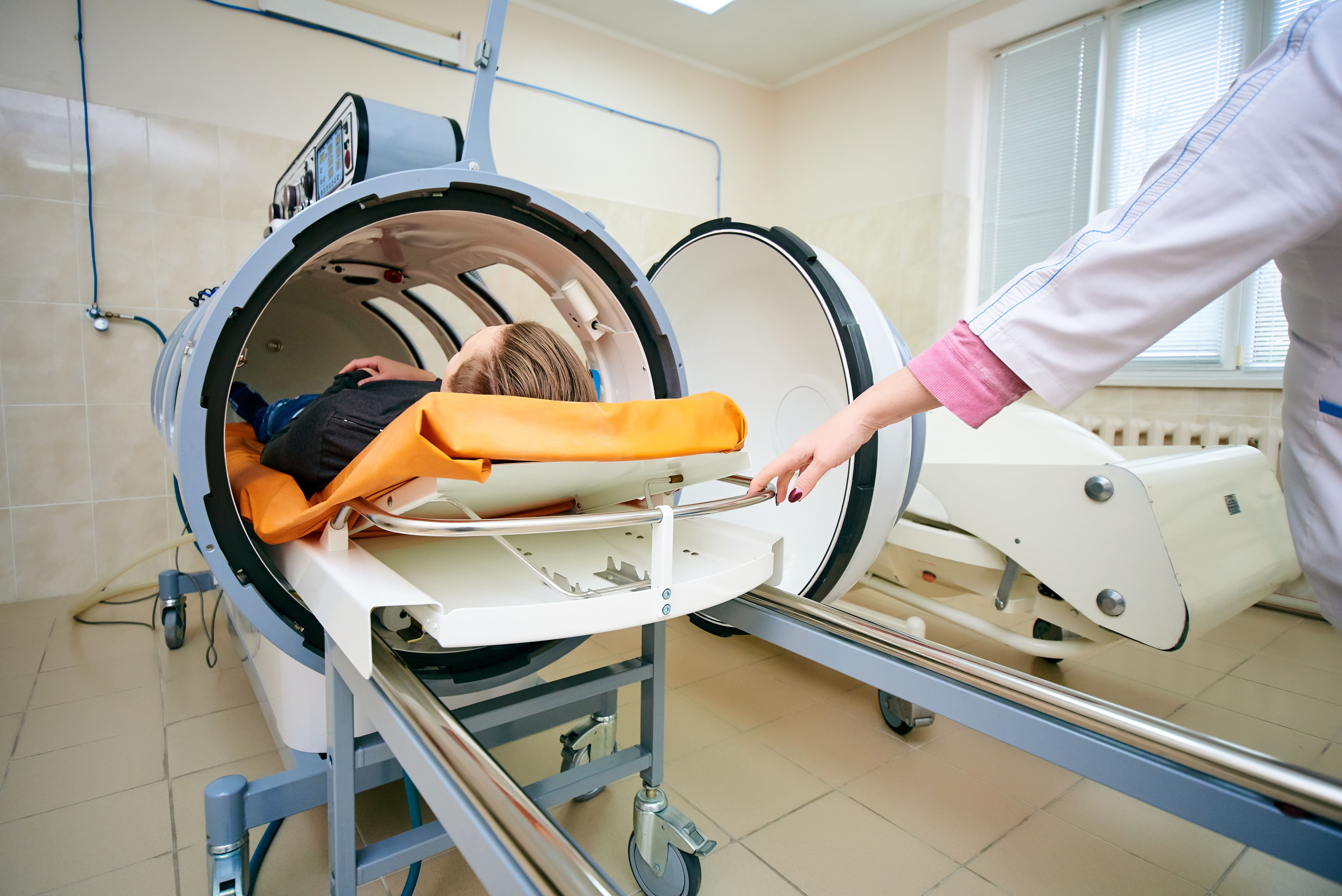
The important thing to remember about this procedure is that it’s carefully controlled by medical professionals. It’s not something that can be done on a whim because your doctor will first need to carefully consider your health and determine whether or not you will benefit from it. If you’re exposed to highly pressurized oxygen for an extended period of time, you could pose a serious risk to your health.
Key Benefits of HBOT
Wound healing
Chronic wounds are wounds that take a long time to heal. Oftentimes, the reason for this slow healing is due to poor circulation or hypoxia (lack of oxygen in the tissue). During HBOT treatment, the supply of oxygen to these tissues will increase which will promote a faster and smoother healing process. Diabetes patients commonly use HBOT because they often suffer from neuropathy (nerve damage) which slows or prevents wound healing.
Skin Cell and Collagen Development
Hyperbaric oxygen therapy has many different anti-aging effects. Collagen is a component of your skin that’s largely responsible for the healing and recovery of wounds, but it also affects the condition of your skin. Skin with a lot of collagen will look more youthful, elastic, and won’t become damaged or scar as easily. Oxygen therapy can help with the production and management of collagen in the body.
Strengthening the Immune System
Innate and adaptive immunity are two of the most important functions of your body. When you ingest any type of foreign bacteria your body is at constant war to protect you from these harmful substances. HBOT is known for being able to disable the toxins of certain bacteria, effectively making them less of a threat to the immune system and the body as a whole. What’s more, oxygen therapy helps white blood cells find and destroy foreign invaders. In some cases, neutrophils even use oxygen radicals to kill invading pathogens.

Preventing Reperfusion Injury
Reperfusion injury is a phenomenon that occurs when oxygen-rich blood returns to a tissue that was previously deprived of oxygen. Reperfusion can result in damage to the tissue, inflammation, and even cause blood vessels to clamp, reducing blood flow to the area. HBOT works to generate scavengers that destroy oxygen radicals which are responsible for tissue damage.
Curing Decompression Sickness
Decompression sickness is a condition commonly contracted by divers who return to the surface too quickly. Due to the rapid change of pressure, bubbles of gas can form in the blood causing symptoms such as dizziness, rashing, fatigue, and chest pain. While decompression sickness is uncommon, it can be serious or even fatal if it isn’t treated swiftly. HBOT is the only effective treatment for decompression sickness because it reduces the size of the gas bubbles, fills the tissues with oxygen, and reduces swelling.
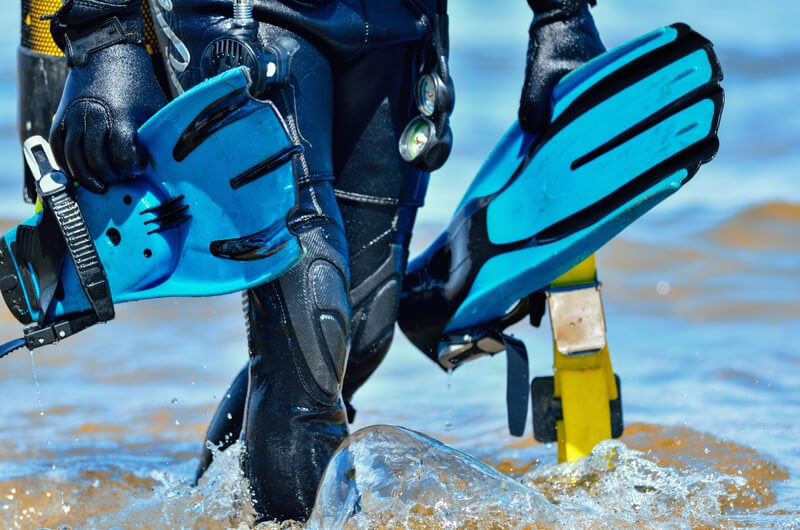
Disadvantages of HBOT
The only disadvantage of HBOT is overexposure. Patients should not be in a hyperbaric chamber for more than 2 hours at a time and they should not be exposed to pressure that is greater than 3 times that of the atmosphere. People with certain lung conditions, a cold or fever, or those who have recently had ear surgery should not consider HBOT.
{{cta('b59df0c1-c4de-47a8-8e1c-0d33d4b414aa','justifycenter')}}
Compressed Oxygen Gas
Compressed oxygen tanks are commonly used in both hospitals and in homes. Despite being thrown in with hyperbaric oxygen therapy, oxygen tanks are used in very different situations. Whereas HBOT is used to repair tissue damage and cure decompression sickness, oxygen tanks are commonly used to treat lung conditions such as chronic obstructive pulmonary disease (COPD), cystic fibrosis, pneumonia, and more.
-min.png)
Another significant difference between oxygen tanks and HBOT is that oxygen there is no compression aspect. While oxygen is compressed inside the tank, you won’t need to be in a pressurized room or use a special pressurized facemask. Oxygen therapy is commonly administered through the nose via a nasal cannula but face masks can be used as well depending on the situation.
How Do Oxygen Tanks Work?
Oxygen tanks — typically made of aluminum — are filled with medical-grade oxygen. The process that oxygen manufacturers use to fill these tanks maximizes their oxygen concentrator and limits any impurities that could affect the patient’s health. The pressure inside these aluminum tanks reaches about 2,200 pounds per square inch (PSI). To put this into perspective, the average car tire has a PSI of about 32 to 35, so oxygen tanks are considerably more than this. As you can imagine, this makes them pretty dangerous to keep around unless you avoid dropping them or bumping into them.
.jpg)
Compressed oxygen comes in two forms: home oxygen tanks and portable oxygen cylinders. Since oxygen can only be compressed so much, the size of an oxygen tank directly correlates to the amount of oxygen it can hold. Home oxygen tanks are large and bulky but they can hold quite a bit of oxygen. Portable oxygen cylinders like the “E” cylinder, however, weigh around 8 pounds and they can carry up to 6 hours worth of oxygen.
Key Benefits of Compressed Oxygen
Reduced COPD Symptoms
COPD is characterized by symptoms such as breathlessness, chronic fatigue, chest pain, coughing, and wheezing. All of which are very difficult to live with, especially in later stages of the disease. Using compressed oxygen for the amount of time prescribed by your doctor will ensure that your oxygen levels remain stable and symptoms are kept at a minimum.

Reduced Hospital Admissions
High hospitalization rates are a major problem for COPD patients. No matter where you are or what you’re doing, there’s always a chance that you could experience a COPD exacerbation that could put you in the hospital for days or even weeks. Not only do hospital admissions cost a fortune, but they’ll take you away from what you’re doing. Studies show that long-term oxygen therapy reduces the risk of hospitalization.
Disadvantages of Compressed Oxygen
The most notable disadvantage of compressed oxygen is how bulky, heavy, and dangerous it is. Even the smallest and lightest ones on the market are typically too heavy to carry by hand. Most people prefer to either put them in a backpack or use a rolling cart to transport them. What’s more, they aren’t approved by the Federal Aviation Administration (FAA) so you won’t be able to take them on a flight with you.
Liquid Oxygen Tanks
Liquid oxygen is used for the same purpose as compressed oxygen: to support healthy oxygen levels in COPD patients. However, since oxygen takes up less space in its liquid form, liquid oxygen is a better choice for people who want to stay out for longer without having to refill their oxygen tank.
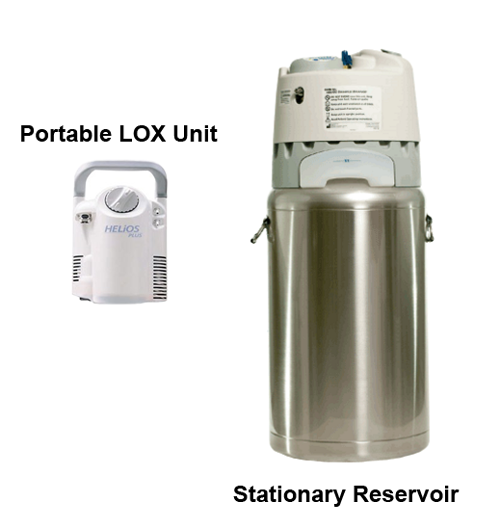
In order for oxygen to be stored in a liquid state, it needs to be cooled to around -297 degrees Fahrenheit. So, in general, liquid oxygen tanks are more advanced and require more training to use than a compressed oxygen tank. As such, liquid oxygen is typically not prescribed for short-term use.
Key Benefits of Liquid Oxygen
Carry More Oxygen Than Compressed Tanks
The main reason someone would choose a liquid oxygen tank over compressed oxygen is that it offers significantly more oxygen. If you have high oxygen flow needs, you can rest easy knowing that you can stay out all day without having to refill the tank. You likely won’t need to resort to something like a pulse dose regulator which is designed to conserve oxygen which is a good thing because they can add weight and make the device more complicated to use.
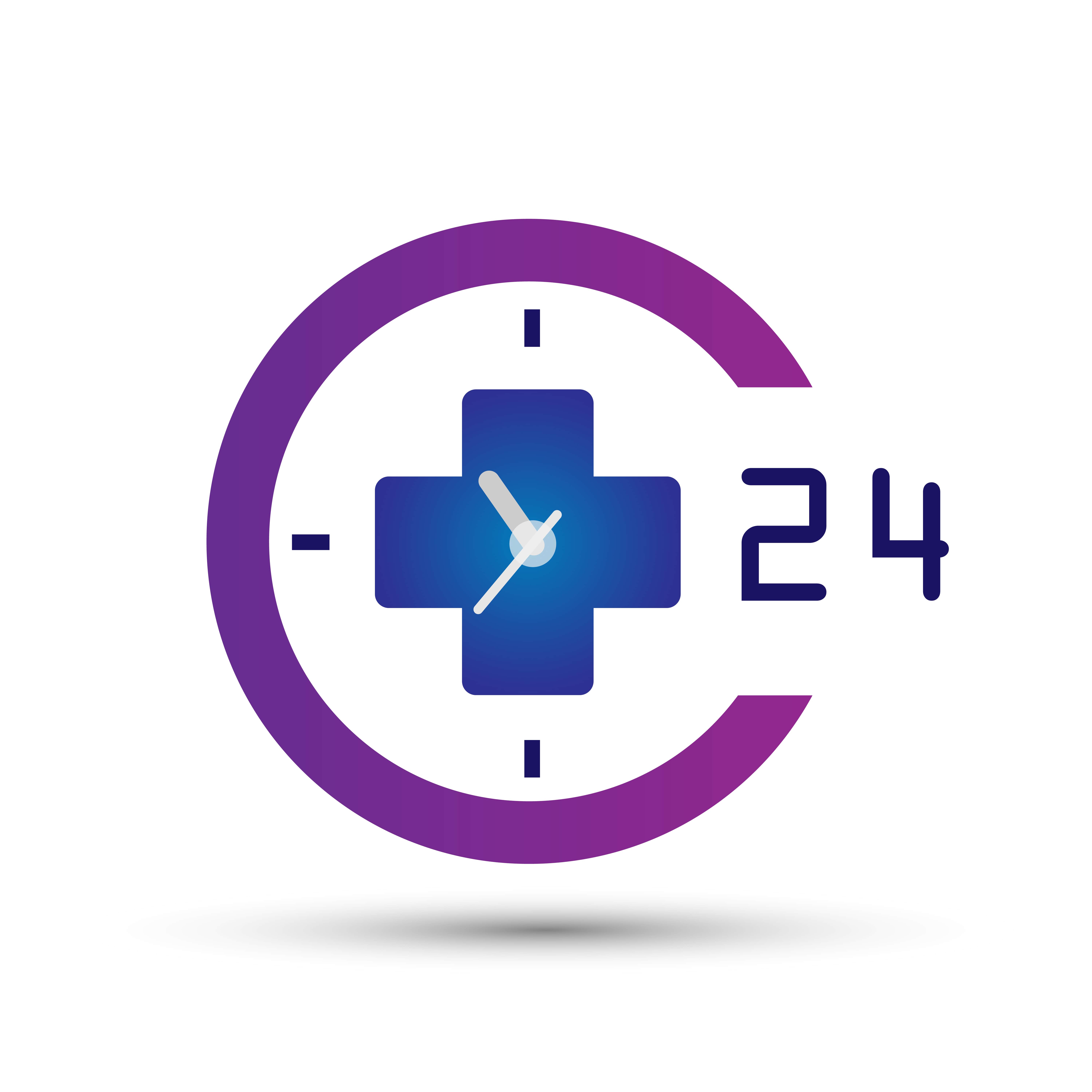
Much Safer to Use
Another reason to go with liquid oxygen over compressed oxygen is that it’s much safer to use. Compressed oxygen is stored at very high pressures making it very dangerous to carry around or keep in your home. Liquid oxygen, on the other hand, is stored at very low temperatures because it doesn’t expand as much when it’s in its liquid form.
Disadvantages of Liquid Oxygen
The most notable downside to liquid oxygen is the cost. Due to the additional technology needed to keep oxygen at such low temperatures, you should expect to pay significantly more. It’s also a lot harder to find someone who can fill a liquid oxygen tank for a reasonable price. Despite the high costs, many people find that liquid oxygen is worth it due to the amount of freedom it offers.
Oxygen Concentrators
Oxygen concentrators are the newest form of oxygen therapy on the market. They’re used for the same purpose as compressed oxygen and liquid oxygen (treating chronic lung disease) but they’re battery operated. What this means is that as long as you have access to a functional battery, you’ll have an infinite supply of oxygen wherever you go.

Rather than holding oxygen like oxygen tanks, oxygen concentrators draw in ambient air and remove non-essential gases like nitrogen, argon, and carbon dioxide. They then put out pure medical-grade oxygen through the nasal cannula. Since there’s more that can go wrong with an oxygen concentrator, it’s important that you purchase one from a reputable brand like Inogen, AirSep, or Caire Inc.
There are three different types of oxygen concentrators on the market: home oxygen concentrators, portable continuous flow concentrators, and portable pulse flow oxygen concentrators. Home oxygen concentrators (stationary oxygen concentrators) need a wall outlet in order to operate whereas portable oxygen concentrators run off a battery.
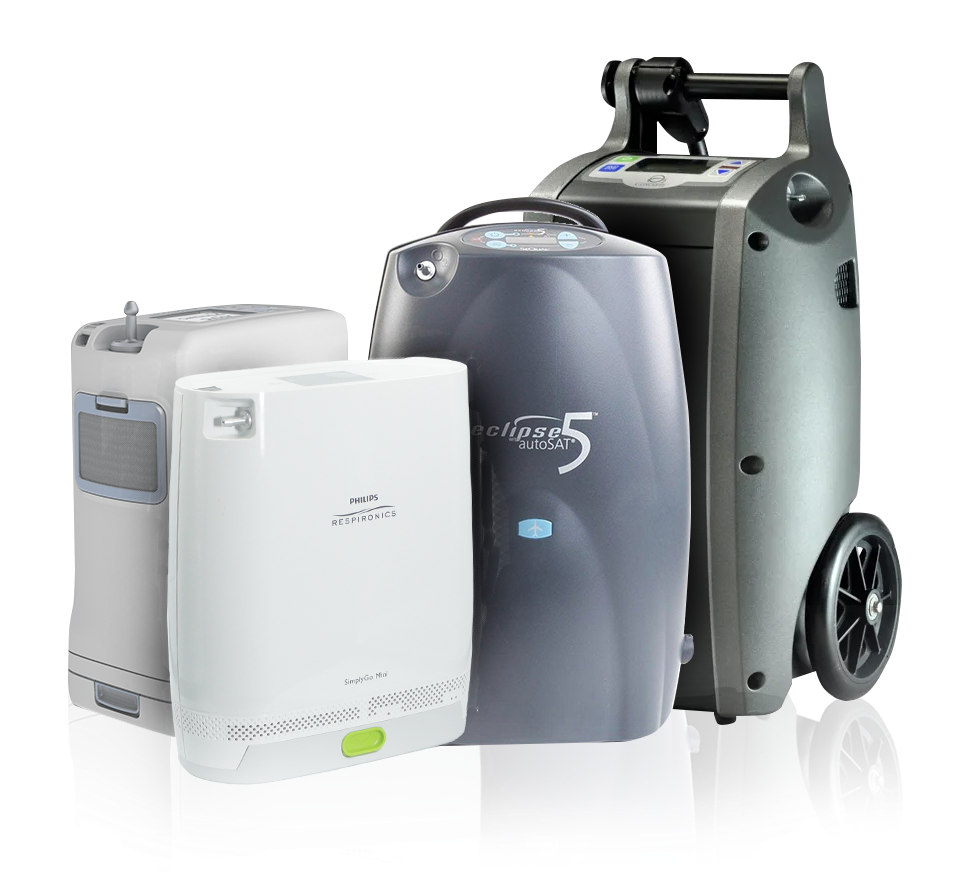
Continuous flow oxygen concentrators are similar to oxygen tanks in that they put out a constant stream of oxygen. They tend to be bulky, usually weighing in at over 10 pounds. Pulse flow oxygen concentrators have additional technology built into them that only puts out oxygen when the user inhales. As such, they are more efficient, lightweight, and small.
Key Benefits of Oxygen Concentrators
No Refills
The greatest part about oxygen concentrators is that they never need to be “refilled” like oxygen tanks do. Simply charge the batteries and you’re good to go. Many POCs even come with car chargers so you can feel free to take a road trip or drive long-distance without ever running out of oxygen.
Very Small and Lightweight
By using compressed oxygen or liquid oxygen, you’re significantly restricting your freedom. Most oxygen tanks need to be wheeled around using a rolling cart but pulse flow portable oxygen concentrators can easily be carried at your side. Most pulse flow units weigh under 6 pounds and some are even small enough to fit in a purse or on your belt.
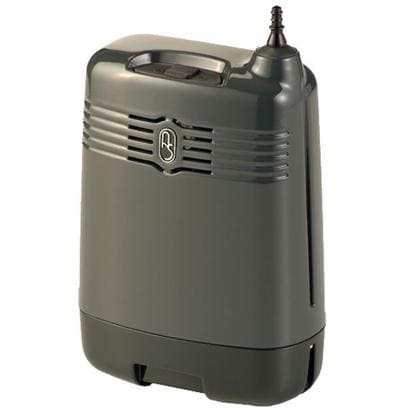
Safe to Use
While liquid oxygen tanks are significantly safer than compressed oxygen, they still can’t compare to pulse flow oxygen. Since oxygen concentrators don’t hold onto any oxygen that they use, there is no chance of them exploding or creating a fire. All of the oxygen that’s administered goes directly to the nasal cannula. Because of this, oxygen concentrators are the only oxygen therapy devices approved by the Federal Aviation Administration (FAA) for in-flight use.

Disadvantages of Oxygen Concentrators
For the vast majority of oxygen patients, oxygen concentrators are the ideal solution. However, there are some potential downsides depending on your situation. If your pulmonologist wants you to use continuous flow oxygen, you’ll have to either use a home oxygen concentrator or a continuous flow portable oxygen concentrator. While you can take these machines just about anywhere, they tend to be bulky and heavy. But most patients would say that they still offer significantly more freedom than oxygen tanks.
Conclusion
There are several different types of oxygen therapy out there so it’s important that you don’t get them confused. Hyperbaric oxygen therapy is a form of short-term oxygen therapy. It can be used to treat conditions like decompression sickness or to prevent reperfusion injury. Hyperbaric oxygen therapy should only be administered by a medical professional under controlled conditions in order to prevent oxygen toxicity.
Oxygen tanks, liquid oxygen tanks, and oxygen concentrators are more commonly used in a long-term setting in order to treat lung conditions like COPD, cystic fibrosis, and pneumonia. These oxygen devices are often prescribed to be used for several hours a day or even 24/7 if the situation demands. Compressed oxygen has been the industry standard for many decades but it’s becoming much less popular due to the freedom and independence liquid oxygen and portable oxygen concentrators have to offer.
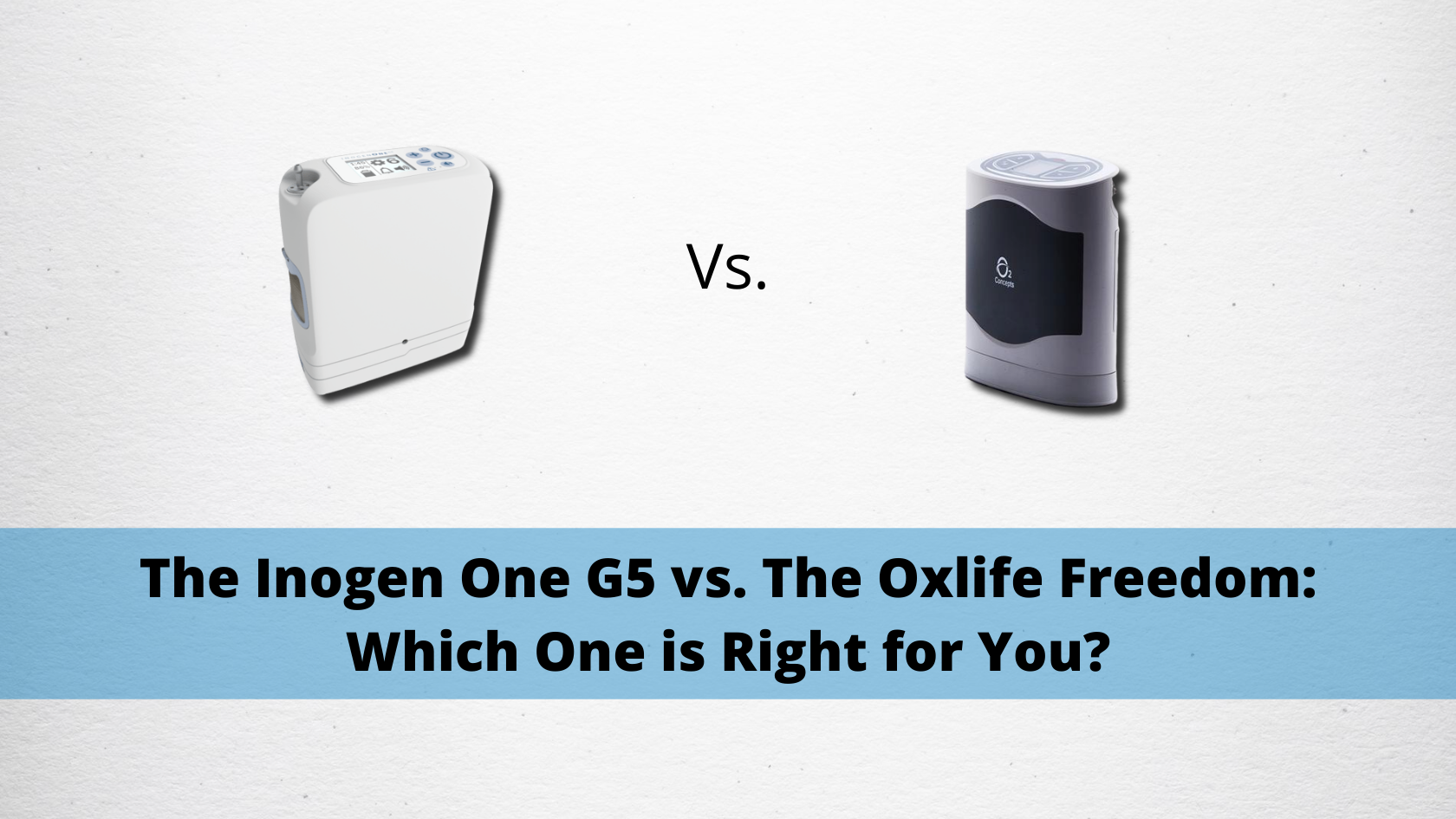
It’s a new year and a new decade which means it’s time to start working on those resolutions you’ve been planning in 2019. For some of us, that means getting to the gym more often or creating a more solidified financial plan. But if you suffer from chronic obstructive pulmonary disease (COPD), treating your condition might be at the core of your resolutions.
While COPD is an incurable disease, the good news is that there are virtually endless ways to treat it and improve your life. By making adjustments to your lifestyle, crafting a flawless COPD action plan, and taking time to reevaluate your goals, you’ll be well on your way to living a more healthy and productive life.
Another thing you should consider doing in 2020 is replacing that old oxygen tank, liquid oxygen tank, or home oxygen concentrator you’ve been using. Medical oxygen technology has come a long way in the past couple of years, so you’ll be happy to know that there are plenty of options available to you. If you haven’t done so already, we highly recommend upgrading to a portable oxygen concentrator.
Portable oxygen concentrators use something called pulse dose technology. Rather than putting out a constant stream of oxygen like an oxygen tank or continuous flow oxygen concentrator, pulse dose only delivers oxygen when you inhale. Because pulse flow concentrators require less processing power, oxygen device manufacturers are able to make them much smaller and lighter than their counterparts.
To help you pick the best portable oxygen concentrator for you in 2020, we’re going to compare two of the most dependable units on the market: the Inogen One G5 and the Oxlife Freedom.
{{cta('fa8abc2a-1e88-4fa3-82fd-1cb5b9ed43b2','justifycenter')}}
Oxlife Freedom Overview
The Oxlife Freedom is one of two portable oxygen concentrators released by O2 Concepts. This company was founded with the goal of providing oxygen patients with a better solution to their needs that doesn’t involve lugging around a heavy oxygen tank. To accomplish this, they released the Oxlife Freedom and the Oxlife Independence.
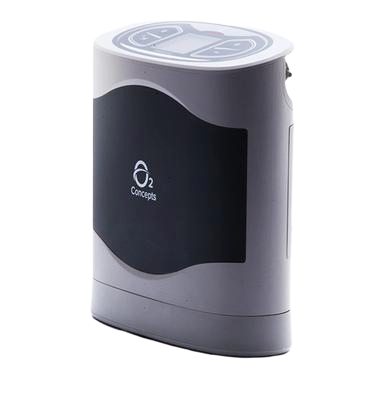
The Oxlife Independence is a continuous flow portable oxygen concentrator praised for its high oxygen output, lightweight design, and FAA approval. In many ways, the Oxlife Freedom is the pulse flow alternative to the Oxlife Independence offering two distinct ways to experience freedom in your daily life, based on what your oxygen needs are.
One notable feature of both units is something called Dynamic Network Analysis® (DNA). This is a service that links all O2 Concepts oxygen concentrators to one secure, proprietary network. This system automatically manages your oxygen usage, equipment status such as oxygen purity and temperature, as well as important maintenance information.
Inogen One G5 Overview
Much like O2 Concepts, Inogen was founded with the mission to provide oxygen users with reliable portable oxygen that can be transported anywhere with ease. Since the early 2000s, Inogen has released one home oxygen concentrator: the Inogen at Home and five pulse flow oxygen concentrators. The latest pulse flow unit is the Inogen One G5 which was released in the summer of 2019.
.png)
Inogen never shies away from producing feature-rich and industry-leading portable oxygen concentrators. In fact, oxygen retailers and oxygen patients across the world eagerly await the release of new Inogen products because they know it will be a reliable device that they can use for years to come. The Inogen One G5 is considered by many to be the best POC on the market with the longest external battery life and the highest oxygen output of any pulse flow unit.
Oxygen Output
Each time we do a portable oxygen concentrator comparison, we always start with oxygen output. This is always the most important aspect of a POC because if your oxygen needs aren’t met, you’re going to need to find a unit that does meet them. One important thing to note is that pulse flow concentrators are not measured the same was as continuous flow ones. Continuous flow POCs are measured in liters per minute (LPM) and pulse flow concentrators are measured in pulse flow settings or maximum oxygen output.
At this point in time, the Inogen One G5 has the highest oxygen output of any pulse flow POC on the market. The G5 is the only pulse flow machine that goes up to a setting of 6 with a total oxygen output of 1260 ml/min of 90% (+6%/-3%) oxygen. This is the equivalent of 210 ml for each pulse flow setting. Although the Oxlife Freedom does not provide as high of an oxygen output as the G5, it puts out a respectable 44 ml per bolus (breath). At a normal breathing rate of 20 breaths per minute (BPM), that’s about 880 ml/min. If your breathing rate increases, the size of each bolus will decrease.

For the large majority of patients, the Inogen One G5 and the Oxlife Freedom will provide enough oxygen for day-to-day use. However, it’s important to note that the G5 provides more wiggle room in case your symptoms worsen. As you’re likely aware, COPD is a progressive disease meaning it slowly gets worse over time. The G5 will ensure that you still have a reliable medical oxygen machine for years to come.
Battery Longevity
Whether you’re going for a quick trip to the store or a vacation out of the country, you need enough battery life to keep you going. For many patients, this is the biggest concern because they don’t want to deal with the anxiety of rushing home to plug in their oxygen concentrator. You’ll be happy to know that both the Oxlife Freedom and Inogen G5 offer ample battery life. However, there are a few things to take note of.

Both the G5 and Oxlife Freedom come with a single-cell battery. The G5 comes with up to 6.5 hours of battery life on a setting of 1 and the Oxlife Freedom comes with a 5-hour battery life on a setting of one. With the double battery, this is increased to 13 hours with the G5 and 10 hours with the Oxlife Freedom. So if you’re looking for as much freedom as possible, the G5 should be your first choice. If you’re not planning on being out of the house for long, then either concentrator will work for you.
Weight
No matter where you go with your portable oxygen generator or how long you’re out, weight is always a factor. A heavy unit can cause back pain and maybe even require you to use a higher flow setting than you’re used to. Fortunately, the G5 and Oxlife Freedom can easily be carried on your shoulder without the need of a carrying cart.
With the single-cell battery attached, the Oxlife Freedom weighs 5 pounds and the G5 weighs 4.7 pounds. While this may sound significant it’s fairly insignificant in the grand scheme of things. However, once again, it will depend on your situation and what you’re expecting out of your portable oxygen concentrator.
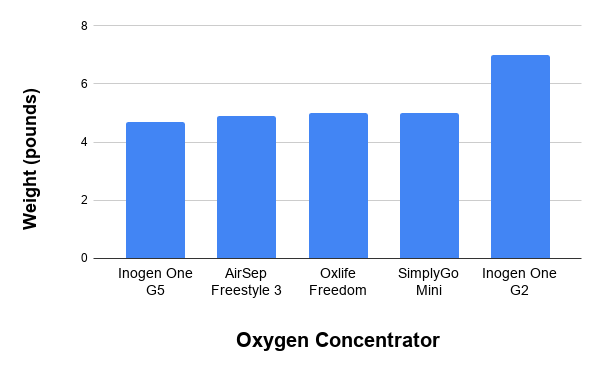
If your goal is to travel, the G5 will offer you more flexibility when it comes to the personal belongings you can carry. For example, you could carry an extra battery if you want to stay out longer or maybe you want to carry a water bottle or other personal belongings. You’ll have this option with the Oxlife Freedom too, but note that you’ll have an extra 0.3 pounds weighing you down.
{{cta('b59df0c1-c4de-47a8-8e1c-0d33d4b414aa','justifycenter')}}
Sound Level
When it comes to pulse flow portable oxygenators, sound is usually never an issue. They’re naturally much quieter than continuous flow concentrators, but it’s worth bringing it up since it’s a concern for many people. On a setting of 2, the G5 runs at a quiet 37 decibels which is comparable to a soft whisper. The Oxlife Freedom, on the other hand, is about 46 decibels.
Many oxygen patients describe portable oxygen concentrators like a refrigerator. At first, you’ll notice the noise, but the longer you have it, the less you’ll notice it. They’re quiet enough that they won’t disrupt anyone else either. For example, you’ll be able to sit through a church service or visit the library without feeling like you’re bothering anyone around you.
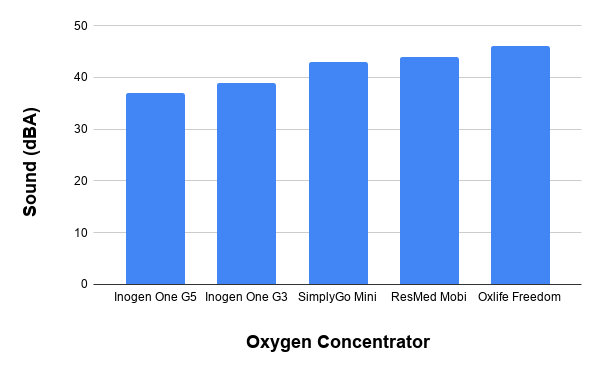
With that being said, there is a noticeable difference between the sound level of the G5 and the Oxlife Freedom. The Inogen One G5 offers much quieter operating sound levels even on higher flow settings and if you need to sleep with your oxygen concentrator on, it will be much easier to get to sleep while using the G5. So, if this is something that concerns you, the G5 will be your safer option.
Additional Features
One thing that’s very unique about the G5 and the Oxlife Freedom is that they both offer plenty of additional features that make them unique. It’s fine having a POC that meets your basic requirements, but it’s also nice having one that goes that extra step and exceeds all your expectations.
Dynamic Network Analysis® (DNA)
The most notable extra feature of the Oxlife Freedom is its Dynamic Network Analysis® (DNA) which we talked about earlier. This feature is really unique because it makes the Oxlife Freedom and Oxlife Independence the only portable oxygen concentrators to be fully connected to the internet no matter where you are in the world. This has deemed it the name, “the world’s first smart POC.”
The DNA feature has a number of functions. First and foremost, the system is designed to prevent instances of COPD hospital readmittance. Generally, one day spent in the hospital for a COPD exacerbation is costlier than an entire year’s worth of oxygen therapy. With DNA, O2 Concepts is able to track the integrity of the oxygen concentrator, as well as your usage habits to ensure you’re getting the oxygen you need throughout the day.
Another thing that DNA enables you to do is monitor the condition of your device. Even the best POCs out there need maintenance every once in a while, but with this feature, you’ll never have to worry about when that time comes. It also gives you the security you need to travel the world knowing that your device is connected to a secure, proprietary network.
Inogen Connect
The Inogen Connect was first implemented with the Inogen One G4, and due to popular demand, it was implemented with their latest unit, the G5, as well. The Inogen Connect is a smartphone application that connects to your Inogen portable oxygen concentrator via Bluetooth. By simply turning on your phone you’ll see real-time information about your concentrator’s status including column condition, battery life, and much more. You’ll also have access to the Inogen One G5 user manual for quick troubleshooting reference.

The Inogen Connect is incredibly easy to use and takes just seconds to set up. If you like to keep your G5 on your back with the Inogen One G5 backpack, this is the easiest way to get up-to-date information about it without ever having to look at it. Simply pull out your phone and open the application. The best part about all of this is that it’s absolutely free to use!
The Best Candidate for the Oxlife Freedom
With the release of the Oxlife Freedom and Oxlife Independence, O2 Concepts has established itself as one of the leading POC manufacturers. While the Oxlife Freedom is the only pulse flow unit produced by the company, it’s had a significant impact on the industry. In addition to offering a good battery life, lightweight design, and high oxygen output, the Oxlife Freedom aimed to go above and beyond by keeping oxygen patients connected through the DNA network.

If you’re looking for a pulse flow POC that allows you to get outside for several hours each day and you want the security of knowing exactly the condition of your device, the Oxlife Freedom is for you.
The Best Candidate for the Inogen One G5
Inogen established itself as the industry-leading portable oxygen concentrator manufacturer back in the early 2000s, and they haven’t held up since then. Their latest pulse flow concentrator, the Inogen One G5, is the perfect example of why Inogen’s products stand the test of time.
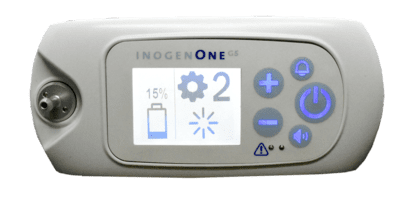
Straight out of the box, the G5 offers the highest oxygen output of any pulse flow POC on the market, narrowing the gap between pulse flow users and continuous flow users. With the double battery (sold separately), the G5 has the longest external battery life of any pulse flow unit, allowing oxygen users to stay out longer and do more. And last but certainly not least, the G5 is backed by one of the most reliable and trusted brands in the industry.
Assuming it meets your oxygen requirements, there really isn’t anyone that we wouldn’t recommend the G5 to. It’s the best portable oxygen concentrator for the greatest number of people and it continues to push the boundaries of what oxygen patients can do.
{{cta('43b79c5e-6bd6-4f02-ac27-2d038d20c146')}}
Conclusion
At the end of the day, it’s hard to go wrong with either the Oxlife Freedom or the Inogen One G5. They both offer oxygen patients the freedom and independence they’ve been craving in order to stay active and achieve more. We recommend the G5 for more patients than the Oxlife Freedom because it excels in areas that tend to be most important to people. However, there are also variable conditions to take into consideration like cost which may lead you to choose one over the other. Be sure to stay tuned to our site to see what deals we’re currently offering on pulse flow portable oxygen machines.
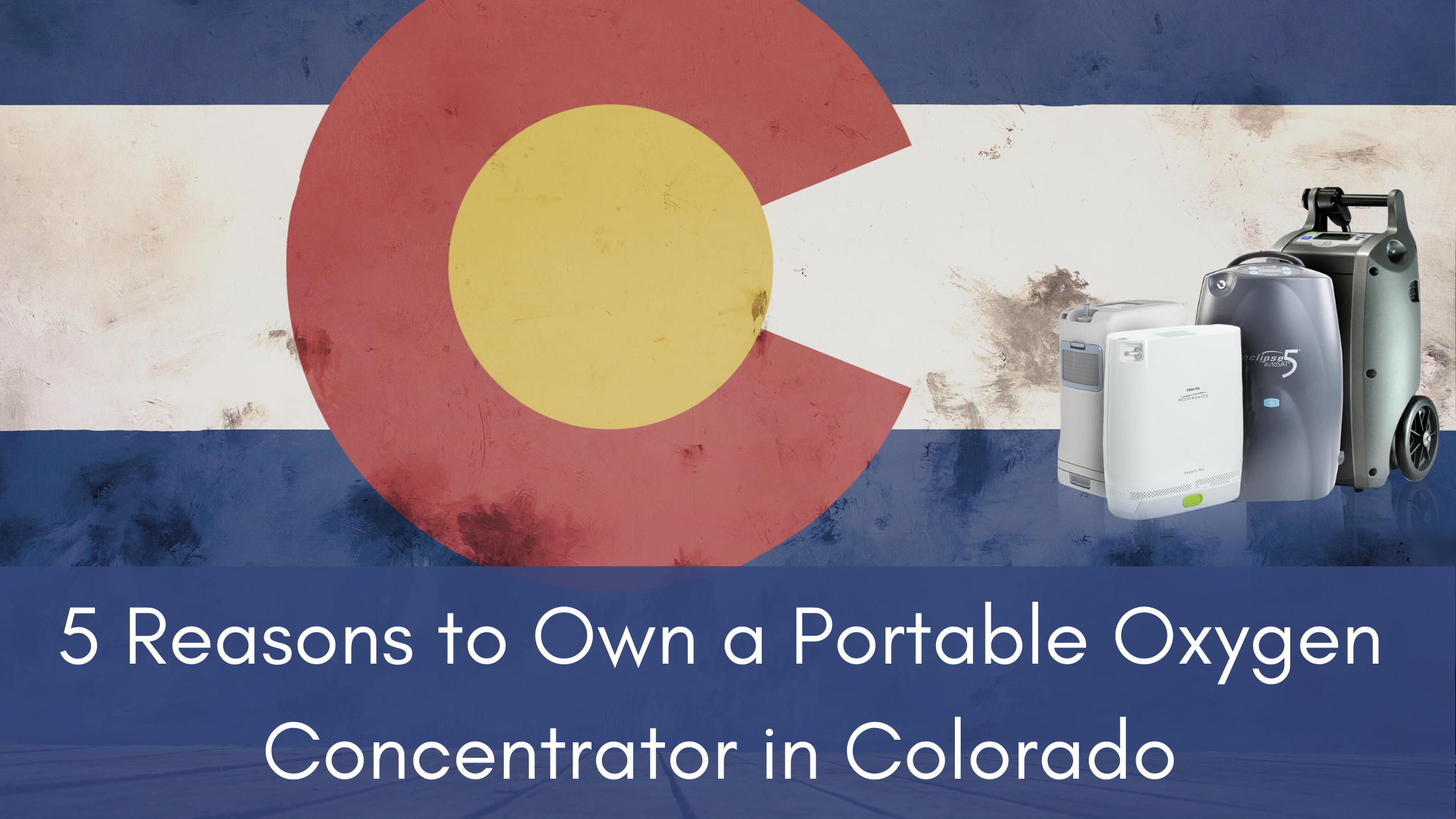
If you have a respiratory impairment like chronic obstructive pulmonary disease (COPD) or pulmonary fibrosis, you’re probably used to carefully planning your day-to-day life. From following your treatment plan to scheduling doctor’s appointments, you need to have an acute understanding of your medical needs and how to address them.
One of the medical needs you may struggle with is supplemental oxygen therapy. Depending on how severe your respiratory illness is, your pulmonologist will ask you to use medical oxygen anywhere from several hours a day to 24 hours a day. Either way, this could mean making sacrifices like staying home from activities to ensure your oxygen needs are met.
Fortunately, there is an alternative to standard oxygen therapy methods like oxygen gas cylinders and liquid oxygen devices. Portable oxygen concentrators were invented in the early 2000s and they offer the same medical-grade oxygen as traditional delivery methods, but they offer it in a much more convenient way that allows you to live life freely and on your own terms.
What’s more, if you live in a state like Colorado, the last thing you want is to be stuck at home when there are so many better things you can be doing. In this post, we’re going to take a look at 7 reasons you should be using a portable oxygen concentrator rather than other medical oxygen devices in Colorado. Remember to always consult your pulmonologist before making any changes to your respiratory treatment plan.
They Work Great at Higher Elevations
Whether you’ve lived in Colorado your whole life or you’re an out-of-stater looking to come here for work or retirement, you likely already know the state’s most defining feature: The Rocky Mountains. People come from all around the country to ski, mountain bike, and simply enjoy the fresh mountain air.
Unfortunately, as an oxygen patient, you know there’s one slight problem with this: the air is much thinner at higher altitudes. What this means is that the higher you go in altitude, the less air pressure there is, and in turn, the less oxygen you have to breathe. This doesn’t just apply to the mountains though; even Denver, the Capital of Colorado is a mile above sea level.
If you have lived at sea level most of your life and don’t travel to higher altitudes very often, you might experience something called acute mountain sickness (AMS). This typically happens when you moved to a higher elevation without giving your body enough time to acclimate to the lower oxygen levels. Anyone can experience acute mountain sickness, but it’s more common and oftentimes more severe in people with COPD or other respiratory illnesses.
Some of the symptoms of AMS include:
- Fatigue
- Dizziness
- Breathlessness
- Nausea
- Headache or lightheadedness
If someone experiencing AMS stays at a high altitude or they continue to climb in altitude, they may experience more severe symptoms including confusion, chest pain, and reduced consciousness. Another condition that can result from AMS is something called high-altitude cerebral edema (HACE). This is a neurological syndrome that causes the brain to swell with fluid and can even result in death if it’s left untreated.

Generally speaking, it’s easier for COPD patients to live at lower altitudes where it’s easier to breathe, but if you want to live at a higher altitude, you should consult your doctor in order to learn how to do it safely. He/she will likely recommend that you start supplemental oxygen therapy or alter your current oxygen therapy plan to adjust for the change of altitude. For example, if you want to travel into the mountains, you may need to use oxygen intermittently in order to maintain your blood oxygen levels while at higher altitudes.
While this is not a commonly known fact, portable oxygen concentrators work great at high altitudes. The Inogen One G5, for example, works at altitudes up to 10,000 feet above sea level meaning you’ll have no problems living in Denver and traveling to the mountains. Be aware, however, that there are several towns in Colorado that are higher than 10,000 feet like Leadville and Alma, so you should only travel to these towns if your doctor specifically advises you to.
.png)
Most portable oxygen concentrators manufactured within the last decade or so offer similar results as the G5 in terms of operating altitude. However, you should be sure to speak with an oxygen concentrator expert before making any decisions.
They’re Great for Road Trips
Taking a road trip is about as American as baseball and apple pie. While not everyone enjoys driving for hours on end or putting thousands of miles on their car, it’s hard to deny its benefits when it comes to seeing more of the country. Colorado is packed with landmarks, but you’re going to need to take a lot of road trips in order to see everything the state has to offer.

Unfortunately, traditional oxygen therapy devices like compressed oxygen cylinders and liquid oxygen tanks make road tripping an impossible feat for most oxygen patients. Oxygen tanks only provide several hours of freedom before they need to be refilled or replaced and this simply isn’t feasible for a long road trip. It’s never easy to find a place to refill oxygen tanks while you’re on the road and bringing a bunch of extra oxygen tanks is cumbersome and takes up a lot of room in the car.
Portable oxygen concentrators, on the other hand, were specifically designed with travelers in mind. These oxygen machines run off of electricity and can be charged from any wall outlet or cigarette outlet in a car via a DC charging cable. So, instead of struggling to find a place to refill your oxygen tank or carrying a bunch of backup units, you’ll have access to an infinite supply of oxygen just by plugging your POC into your car. One thing to note, however, is that most POCs will not run on their maximum flow setting while plugged into the car and you should not charge your POC while the car is off in order to prevent the battery from dying. Refer to your user manual for more information on this.
Another reason portable oxygen concentrators are so much better for road trips is that they’re far safer than traditional oxygen devices. In order to drive with an oxygen tank, you need to take a number of safety precautions because they can explode in certain circumstances. They’re also very bulky and heavy so if they end up getting jostled around in the car, they could injure someone. POCs don’t have these problems because they’re lighter, easier to handle, and don’t have any compressed oxygen.
Hiking is a Breeze
In Colorado, hiking is a popular pastime for people of all ages, and for good reason! Just a short hike every day or two can reduce stress levels, reduce the risk of heart disease, lower blood pressure, and most importantly, allow you to explore a new area that you’ve never been to before. But without an oxygen device that’s manageable, you won’t be able to hike, even if you are physically able.

‘Hiking’ implies that you will be away from pathed paths meaning it won’t be easy to wheel your oxygen device around with a rolling cart. Rocks and other obstacles will make this a lot more trouble than it’s worth and you’ll likely need to take your eyes off where you’re going which can be dangerous. On top of all this, your oxygen tubing will need to run all the way down to the oxygen tank which can be a tripping hazard as well.
While continuous flow portable oxygen concentrators like the Respironics SimplyGo are too heavy to carry on your back or shoulder, pulse dose portable oxygen concentrators like the Caire FreeStyle Comfort are not. Weighing in at just 5 pounds, you’ll be able to hike all day without experiencing back or shoulder pain and with the ergonomic curve of the FreeStyle Comfort, it won’t slide around causing you to lose balance as you walk.
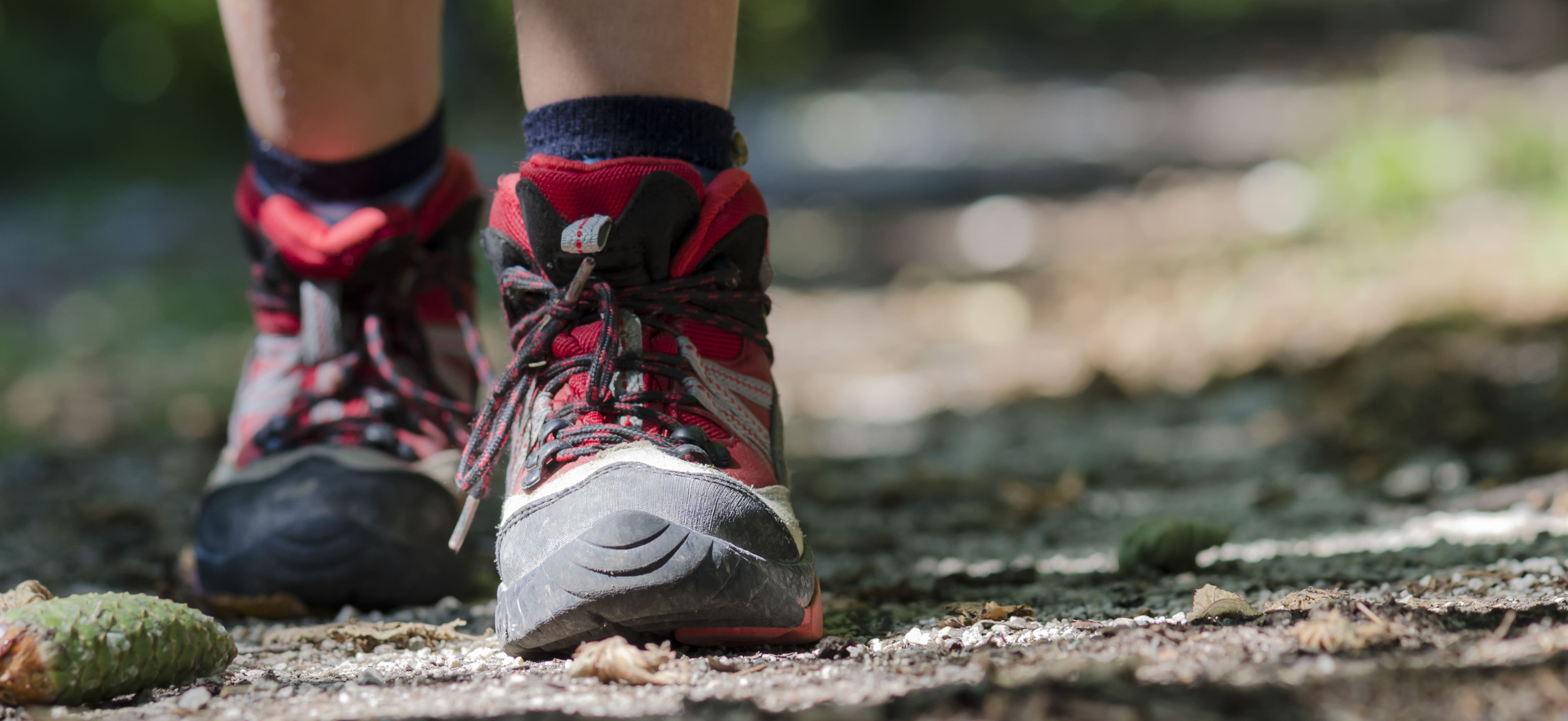
Many pulse dose machines like the Inogen One G3 offer plenty of options in the way of accessories in order to make it more comfortable and easy to carry. For example, there is the G3 backpack which has a compartment to hold the G3 and keep it secure and plenty of other pockets to hold personal belongings like keys, your wallet, or a camera. A similar carrying backpack was also available for the Inogen One G5.
If you’d like to learn more about hiking with a respiratory condition, please refer to one of our latest posts titled “You are Never Too Old for A Walk in the Woods.”
They Could Save You Hundreds of Dollars
There’s no denying that Colorado is a great place to live, especially for seniors and others looking to settle down after retirement. However, that doesn’t mean that it’s the cheapest state to live in. In the grand scheme of things, Colorado is actually pretty average when it comes to the total cost of living, but as we age and stop working, we have to get a little creative with how we spend and save our money.

As an oxygen patient, it may seem counter intuitive to look for ways to save money on your oxygen device. After all, you depend on it every day in order to feel better and improve your life expectancy. However, there are ways to reduce the amount of money you’re spending without increasing your risk of experiencing complications like COPD exacerbations.
While portable oxygen concentrators have a higher upfront cost, they’re actually much more affordable in the long run. For example, the Inogen One G4 retails at $2,295. Given that this machine is set to last 5 to 7 years on average, that’s around $0.90 to $1.20 per day of oxygen use. Compare this to oxygen tanks which cost an average of $5 or more a day to refill and maintain.
Another thing to consider is that most portable oxygen concentrators come with 3-year warranties. This will cover you with a full replacement unit in the event that you received one that is defective. And if you want an extra layer of protection, you can typically upgrade to a 5-year or lifetime warranty for an added cost. This will vary based on the unit that you’re purchasing so be sure to consult with an oxygen concentrator specialist.
Improved Self-Image
COPD and anxiety are two closely linked conditions. Physical symptoms such as chest pain and tightness can lead to natural increases in stress within the body, and people who are naturally predisposed to stress may experience even higher degrees of anxiety. Another thing that can lead to anxiety and even depression in COPD patients is their mindset. For example, someone who has a negative view of their disease and its outcome.
Believe it or not, the oxygen device that you use can also impact how much anxiety you experience. Someone who uses an oxygen tank may feel less capable and thus, experience lower self-esteem. On the other hand, someone who uses a portable oxygen machine may feel more confident because they’re thinking less about their oxygen delivery device and concentrating more on what they’re doing. POC users also report feeling more youthful and active than their oxygen tank counterparts.

If you own an Inogen One G3 we highly recommend accessories like the GO2 Carryalls. This is a stylish carrying bag specifically designed to hold your G3 and other personal belongings. The greatest thing about this bag is that it looks like any ordinary purse or handbag so you don’t have to be self-conscious about carrying around a supplemental oxygen device. It has a sleek leather look and comes in either brown or black so it can match with just about any outfit. It also has a conveniently located zipper so that you have easy access to your oxygen cannula and the G3’s user interface.
Conclusion
Colorado has a reputation as one of the most “outdoorsy” and “active” states in the country. If you have COPD or another chronic respiratory illness, that doesn’t mean you need to give these things up; it just means you need an oxygen device that can match your lifestyle.
Portable oxygen concentrators offer significantly more freedom and independence than other oxygen devices because they’re lighter, smaller, cheaper, and they allow you to stay out of the house for longer without having to search for a place to refill.
{{cta('fa8abc2a-1e88-4fa3-82fd-1cb5b9ed43b2','justifycenter')}}
Pulse dose portable oxygen concentrators like the Inogen One G5 or Caire FreeStyle Comfort tend to be the best option for most people because they’re more reliable than their continuous flow counterparts. If you’re ready to learn more about our portable oxygen concentrators for sale, don’t hesitate to fill out the form at the side of the page or give our respiratory specialists a call.
In the meantime, check out the infographic below to see how pulse dose portable oxygen concentrators stack up against portable oxygen cylinders.
%20(1).png)
-png.png)
Some people need a pulse flow portable oxygen concentrator, meaning your oxygen device detects when you are taking a breath-in, and the machine releases the correct dose of medical-grade purified oxygen.
While oxygen tanks do offer pulse flow settings, you would have to sacrifice your personal freedom to travel or be active due to the restrictive nature of a medical oxygen tank.
Instead you have the option to maintain independence and personal freedom by using the Inogen One G5 portable oxygen concentrator. This device only weighs 4.7 pounds, and is the size of a regular handbag. It even comes with a carrying case, like an over-the-shoulder bag that is sleek and stylish.
You will no longer have to worry about refilling your oxygen tanks. The Inogen One G5 restores your mobility with its portable size, delivering a pulse flow settings up to 6, and it is powered by a rechargeable lithium-ion battery.
There are major advantages of owning or renting the Inogen one G5:
- Weighs only 4.7 pounds
- Long lasting battery life for extended mobility
- Uninterrupted oxygen therapy
- Sleep mode technology for a delivery of oxygen therapy while you sleep
- Powerful pulse flow settings available for exercising, sleeping, severe COPD cases, and emergencies
- It is designed for 24/7 use
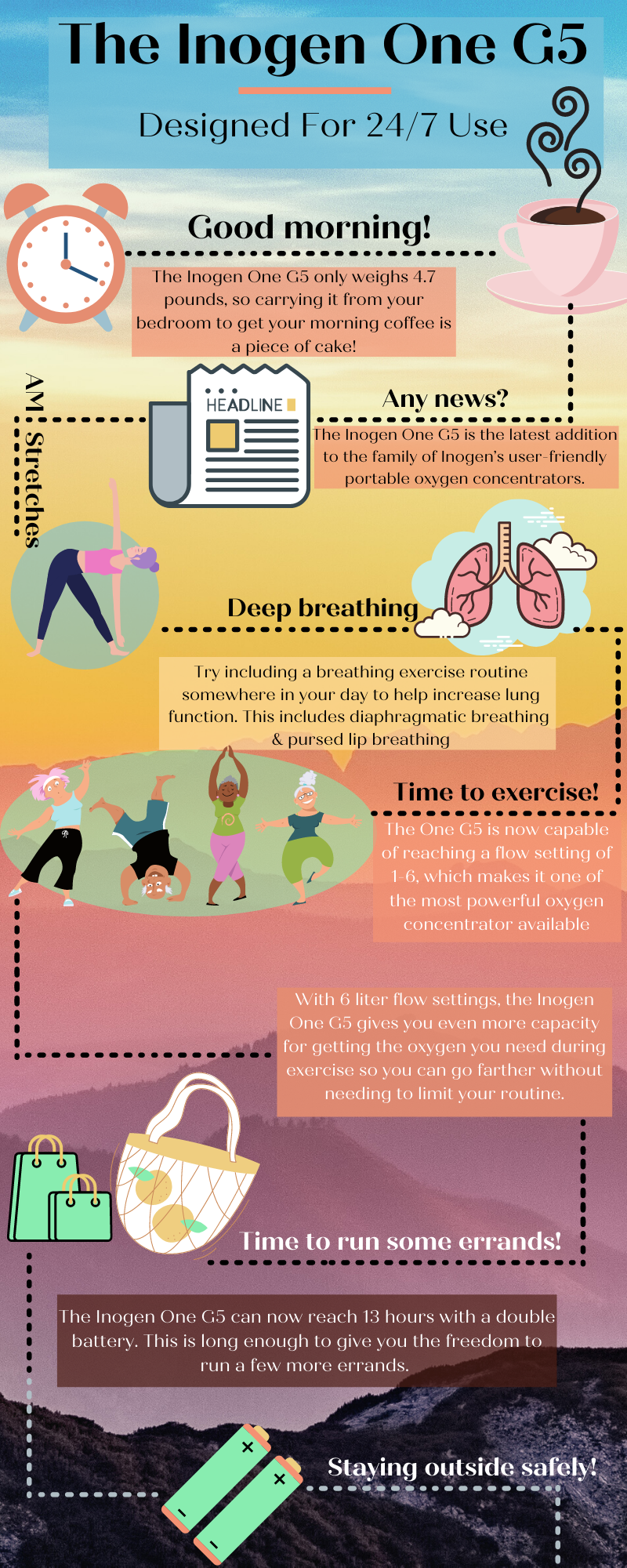
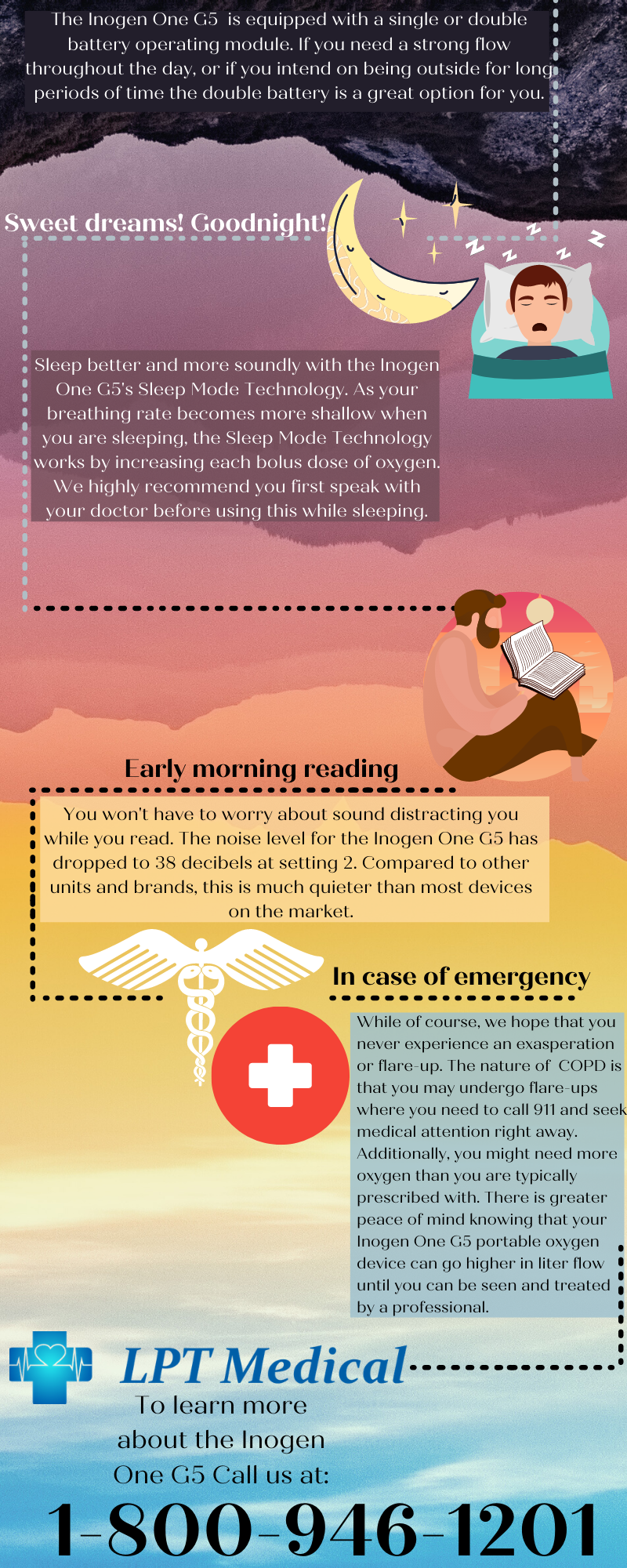
Inogen One G5 when you’re active
The one G5 is now capable of reaching a flow setting of 6, which makes it the most powerful oxygen concentrator available by Inogen, even surpassing their stationary concentrator.
While a higher flow setting might seem like a gimmick if you only need a low setting, there is a benefit to the higher liter flow setting for almost anyone requiring supplemental oxygen. Exercising with COPD can be a challenge because of the higher utilization of oxygen by your muscles, which means you will need to take in more oxygen during your exercise routine.
If your device is not capable of reaching higher liter flows, you might be stuck limiting your exercise routine or only exercising at home where you can use your stationary oxygen device.
With 6 liter flow settings, the Inogen One G5 gives you even more capacity for getting the oxygen you need during exercise so you can go farther without needing to limit your routine.
Inogen One G5 in Cases of Emergency
Additionally, during emergencies, you might need more oxygen than you are typically prescribed with. Although the best strategy for dealing with an emergency is to call 911 or visit your local emergency room, there is greater peace of mind knowing that your portable oxygen device can go higher in liter flow until you can be seen and treated by a doctor or paramedic.
{{cta('fa8abc2a-1e88-4fa3-82fd-1cb5b9ed43b2','justifycenter')}}
Inogen One G5 at Night
You will be able to enjoy these same oxygen delivery benefits at night while you sleep thanks to the presence of Inogen’s intelligent Sleep Mode Technology.
Essentially what this means is that as your breathing rate becomes more shallow as you sleep, the Sleep Mode Technology will go to work by increasing each bolus dose of oxygen.
Even if you are a mouth breather, the Sleep Mode Technology is able to detect shallow mouth breaths that are frequent when sleeping. This will then tell the Inogen One G5 to trigger a bolus dose based upon your specific fixed minute volume.
Now, most of our customers are able to use this technology to sleep with the Inogen One G5, however, we highly recommend you first speak with your doctor before using this while sleeping.
Inogen One G5 when you are traveling
When it comes to portable oxygen concentrators, many people’s oxygen demands cannot be satisfied due to the lack of pulse flow settings. With the Inogen One G5 portable oxygen concentrator that will not be a problem, as this device offers pulse flow settings of 1-6.
That being said, if the setting is set to 6 the battery’s life span will not last as long as it would if the setting was set to 2.
As you go about your day your breathing rate and requirements change depending on if you are laying in bed or exercising. Your doctor will tell you when your setting needs to be adjusted depending on your activity level, if at all. No matter the case, the Inogen One G5 has the ability to satisfy your oxygen demands.
This is a table explaining the Inogen One G5 battery life depending on the setting and whether it is equipped with a single or double battery.
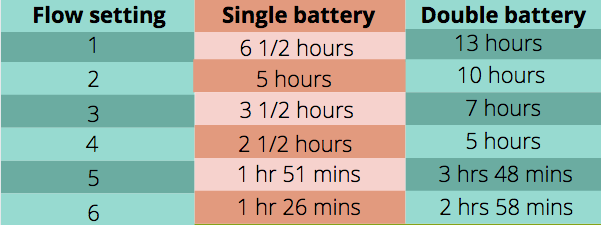
Clearly the double battery gives the One G5 a valuable extension of battery life. This is a great option if you intend on traveling long distances with no source of power or people who need a strong flow setting throughout the day.
If you only need the flow setting to be high at nighttime while you are sleeping, you can have the machine plugged in and not have to worry about the battery life in that case.
Overview of the Inogen One G5
These are the benefits as to why the Inogen One G5 is one of the most effective and versatile portable oxygen concentrators of the market. This unit has the credibility to be effective in helping people in all stages of COPD or any respiratory illness get as close to their lifestyle before they were diagnosed.
{{cta('b59df0c1-c4de-47a8-8e1c-0d33d4b414aa','justifycenter')}}
The high pulse flow setting is great for people who need higher flow when they are exercising or while they sleep.
The extended double battery life gives people the freedom to get outside and enjoy the outdoors, or run their errands for the day on one battery charge.
It is FAA approved, and traveling with the One G5 is a breeze.
The light-weight and compact design gives people who struggle carrying a lot of weight the ability to move around again and re-gain the strength they once had before they were tethered to a heavy oxygen tank.
Over-all the Inogen One G5 could really contribute to building a life, post- diagnoses, where you still feel capable, independent, and strong.
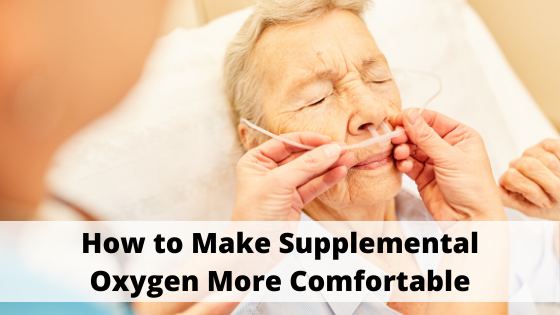
Supplemental oxygen therapy is an amazing, enabling, and life-saving tool that many people with COPD use every day. However, while it can significantly improve how you feel and help you live a better quality of life, supplemental oxygen often comes with its own uncomfortable side-effects and inconveniences.
For example, most patients at some point have problems with ear pain from the ear loops of their nasal cannula. Many patients also struggle to manage their oxygen therapy when they're out of the house, struggling to tote around their equipment and worrying about running out of oxygen before they get home.
Some other common problems that oxygen patients have include dryness and inflammation, which often happens when the constant stream of air through your oxygen delivery device dries out your throat and nasal passages. Another uncomfortable side-effect is skin irritation, which is common on areas of the the face where equipment and tubing touches the skin.
For many reasons, oxygen therapy can be a difficult thing to integrate into your everyday life, especially in the beginning. However, once you work out all the kinks and learn all the little tips and tricks that other oxygen patients have figured out along the way, you'll realize that there are plenty of ways to improve your oxygen therapy experience.
{{cta('fa8abc2a-1e88-4fa3-82fd-1cb5b9ed43b2','justifycenter')}}
In this article, we're going to help you solve these common problems by showing you how to make your oxygen therapy more comfortable in every way possible. We'll show you how to reduce the overall hassle of using supplemental oxygen and get rid of ailments like ear pain, nasal dryness, and skin irritation that many oxygen patients struggle with every day.
Although you can use ear protectors for oxygen tubing or ear pads for oxygen tubing, there is a lot more you can do to make your oxygen therapy experience more comfortable. We'll discuss a variety of simple, practical solutions ranging from recommendations for over-the-counter moisturizing products to tips for keeping your extension tubing out of the way. We'll also show you how to reduce the hassle of lugging portable oxygen tanks around with you everywhere you go, and how to make using oxygen outside your home more convenient and comfortable than ever.
Tips and Tricks to Make Your Nasal Cannula or Oxygen Mask More Comfortable
One of the most common sources of discomfort for people who use supplemental oxygen are oxygen masks and nasal cannulae. You have to wear both of these oxygen delivery devices on your face, which can sometimes be uncomfortable and get in the way of daily living.
Here are some of the most common problems that oxygen patients have with nasal cannulae and oxygen masks:
- Nasal dryness and nosebleeds
- Ear pressure and pain
- Skin irritation
- Soreness
- Tubing getting snagged, twisted, and pulled
- Excess moisture and condensation
Chances are, if you are on oxygen, you've experienced at least a few of these issues on occasion. If you use oxygen continuously, you might struggle with these problems a lot, which can take a significant toll on how you feel and how you live.
However, with the right equipment and accessories, and a bit of creative problem solving, you can significantly reduce or eliminate the frustration and discomfort of using oxygen with a nasal cannula or oxygen mask. In the next sections, we're going to address each of these ailments and show you a variety of tricks and simple solutions you can use today to make your oxygen therapy more comfortable and learn how to prevent cannula marks on the face.
Nasal Dryness and Nosebleeds
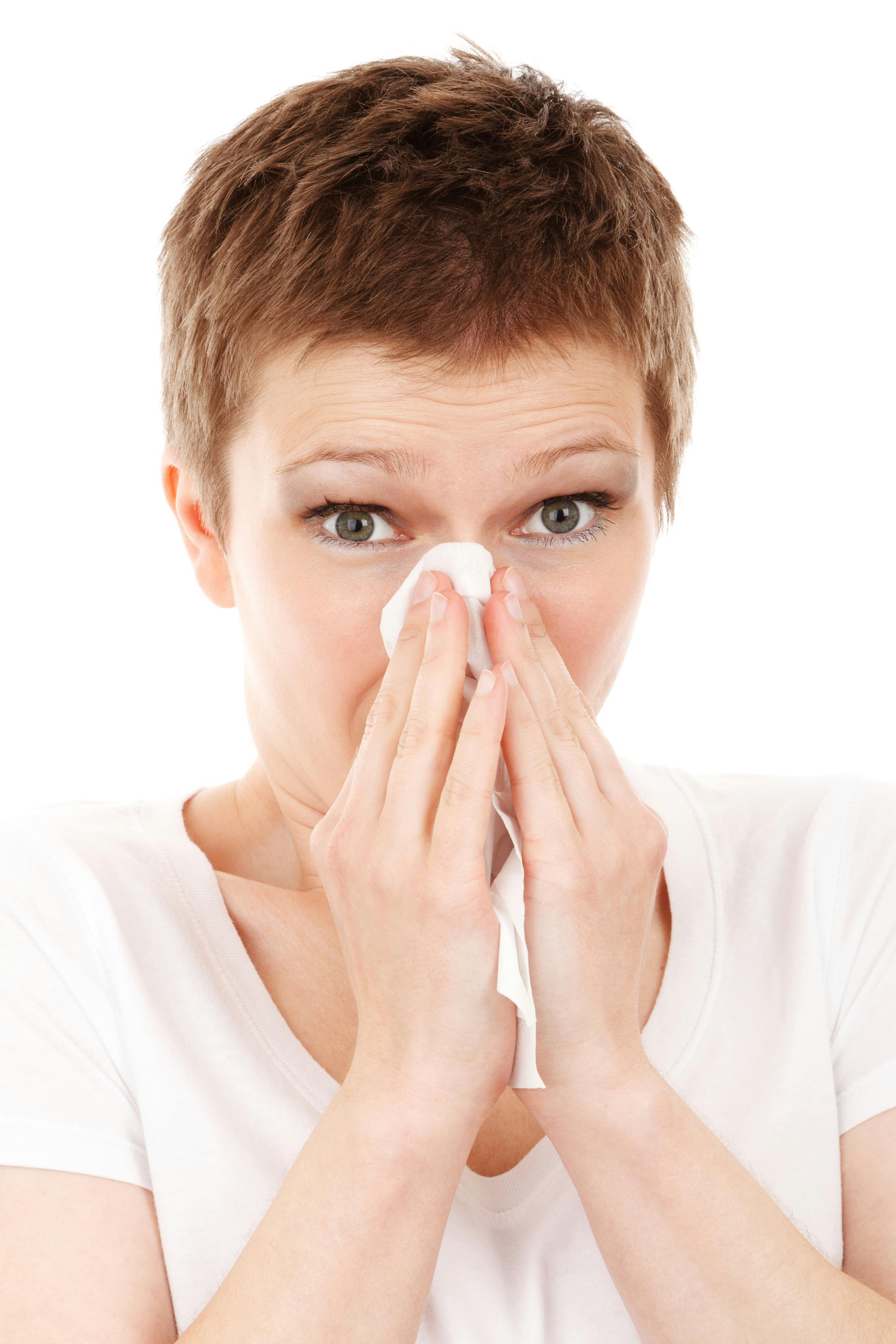
Many people struggle with dry nasal passages or get nosebleeds from using oxygen, especially those who use oxygen continuously or use a high oxygen flow rate. There multiple ways to address this symptom, and most patients are able to find significant relief with a combination of just a few simple techniques.
Besides feeling dry, other symptoms of nasal dryness include increased mucus production, thick or crusty mucus, or mucus that's streaked with red when you blow your nose. These are very common side-effects of oxygen therapy, but you can manage and minimize them using the tools and techniques we discuss in the following sections.
Most oxygen patients experience nasal dryness occasionally, but you should talk to your doctor if it is very severe or if you are unable to manage it on your own. Left untreated, nasal dryness can worsen COPD symptoms and make you more susceptible to getting sick.
Get an Oxygen Humidifier
If you struggle with nasal dryness or experience nosebleeds as a result of your oxygen therapy, talk to your doctor about getting a humidifier bottle with your oxygen delivery device. All you have to do is fill the bottle up with distilled water (not from the tap), hook it up to your tubing, and it will add moisture to the air passing through so that it's more humid by the time it makes it up to your nasal cannula or oxygen mask.
This is often a very effective way to reducing nasal dryness and can make the air that comes from your oxygen supply more comfortable to breathe. They are also cheap and simple to take care of; just rinse your bottle out daily daily rinses and give it a weekly wash with warm water, soap, and vinegar, just like you do for your nasal cannula.
Get a Home Humidifier
If it's wintertime or the air in your house is dry, you might also benefit from getting a humidifier for your home. You can use single-room humidifiers to moisturize the air in small spaces, or you can invest house humidifier for your HVAC system if you want to go all in.
Even just putting a small humidifier in your bedroom at night can make a huge difference, reducing how dry your skin and nose feels and even reducing your chance of nosebleeds. Especially if you live in a climate with low humidity, a humidifier can help you feel much more comfortable every day, and especially when you use oxygen.
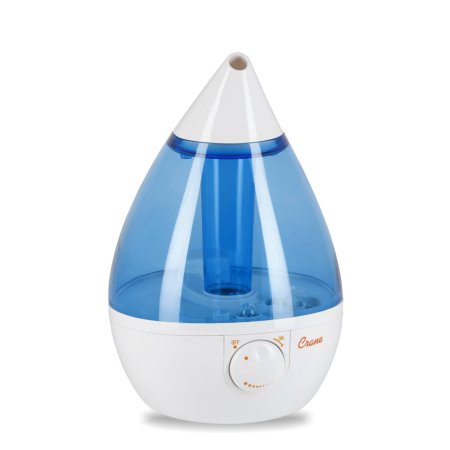
For most people, a humidity level of around forty percent is considered ideal for breathing and comfort. However, some people prefer more or less humidity, and you can adjust your humidifier at home according to your personal taste.
Lubricating Jelly and Nasal Gel

Even if you use a humidifier for your oxygen delivery system and your home, you may still experience nasal dryness on occasion. When this happens, you can use other moisturizing products, like lubricating gels and jellies, that are available over the counter at most superstores and pharmacies.
Nasal gels and jellies are topical lubricating substances that you can apply to the skin inside and underneath your nose. They help seal in moisture in your nasal passage and can reduce friction and soreness caused by the prongs of your nasal cannula.
All you have to do is wash your hands and use your finger or a cotton swab to apply a thin layer of lubricant to the skin just inside your nostrils. You may need to blow your nose after or use a clean towel to remove excess product afterward.
However, don't forget that you should not use petroleum products on your skin if you're going to be using supplemental oxygen, especially on or near your face. Petroleum is very flammable, and when combined with purified oxygen, it becomes even more flammable, raising the risk of serious burns to your face should a fire ignite. Because of this, you should always look for non-petroleum, water-based lubricants instead.
Popular brands of non-petroleum nasal gels include Nasogel, Ayr, and RoEzIt; some patients find that aloe vera works great as well. If you're having trouble finding a gel or have any questions about what nasal lubricant is safe with oxygen, talk to your doctor and ask what products he recommends for you.
Saline Nasal Sprays
Using a saline nasal spray is another effective over-the-counter solution for nasal dryness and soreness caused by oxygen therapy. These products contain a simple solution of water and salt that can be surprisingly effective at soothing and lubricating dry nasal passages.
Note that you should use a spray with a plain saline solution, not the medicated sprays that are often advertised for stuffy noses and colds. Salt water on its own is plenty effective and can be used several times a day, while medicated sprays must be used sparingly and can cause serious side-effects and dependence.

Along with reducing pain and discomfort, moisturizing your nasal passages with a saline spray can also reduce your risk of illnesses and infections. Nasal dryness makes your mucus thick and sticky, raising the risk of trapping harmful bacteria in your airways.
It can also cause the delicate skin in your nose to get dry and cracked, which can make you more likely to get sick. The cracks act like sanctuaries for bacteria, allowing them to multiply and giving them an opportunity to infect your body.
Reducing Skin Dryness and Irritation
Another common problem that patients have with oxygen therapy is dry and irritated patches of skin. Problem areas tend to be the lips, the skin under the nose, and other areas of the face that are near or in contact with your nasal cannula, oxygen, mask, or tubing.
This can be the result of rubbing, chaffing, or the constant flow of air drying out your skin. When you use oxygen continuously, the dryness and irritation doesn't have time to heal, and it will only get worse and worse with time if you don't do something about it.

Luckily, there are plenty of simple solutions for dryness and irritation that can help your skin heal and reduce the chances of future inflammation. In the following sections, we'll discuss a variety of tried-and-true products and techniques that many oxygen patients use to treat skin irritation and make oxygen therapy much easier to deal with.
Use Water-Based Moisturizers on Your Face & Lips
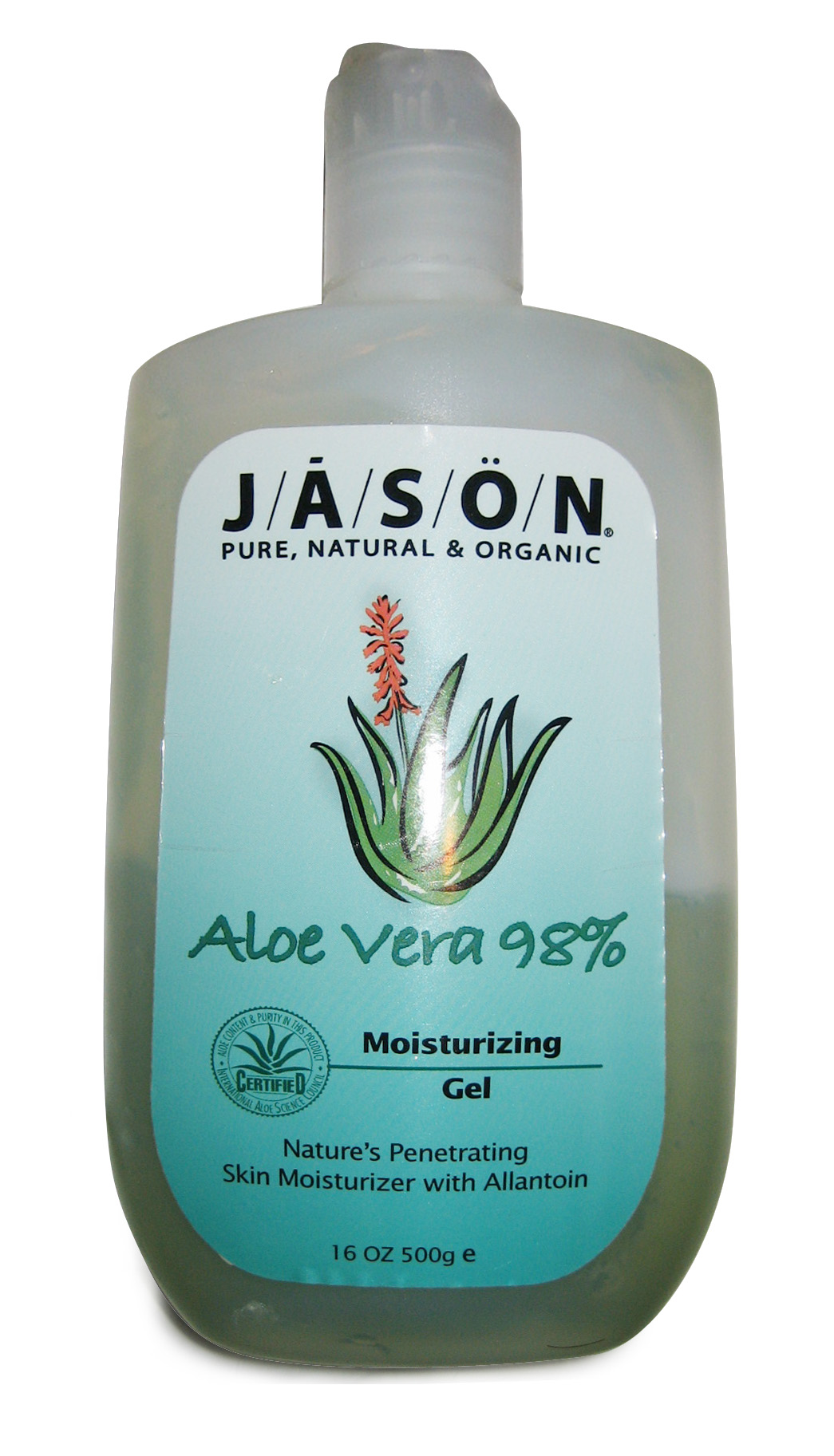
Many of the same moisturizers that you'd use to treat nasal dryness can be used to reduce irritation and chaffing on your skin. Any kind of moisturizing gel or cream can work as long as it's water-based and doesn't contain oils.
Moisturizer can reduce friction and inflammation on any areas of your skin that your head straps, tubing, or other equipment tends to rub against. It's also great for both treating and preventing dry patches that happen as a result of dry air or skin irritation.
Using oxygen can also cause your lips to get chapped, especially if you use an oxygen mask instead of a nasal cannula. You might think the best fix for this is lip balm, but most lip balm brands, including Vaseline, Chapstick, and Blistex, contain petroleum or other oils which can be dangerous to use with oxygen.
Instead, you can use the same water-based lubricants you'd use elsewhere on your skin, like RoEzIt or Vitamin E. You can also find petroleum-free, water-based lip balms from many online retailers that have skin and beauty products for sale.
Use Padding
Many oxygen patients experience discomfort and soreness from tubing, straps, or the edges of their oxygen mask pressing against their skin. In addition to using moisturizers to lubricate the places where the equipment touches your skin, you can use foam and fabric padding to soften the sore points.
There are a variety of different kinds of soft pads and fabric covers you can get to make oxygen masks and nasal cannulae more comfortable to wear. You can find dozens of different options designed to pad all the different areas of your face and head that are prone to experiencing pressure, friction, and discomfort.

For nasal cannulae, you can get small cheek pads to put under the parts of the tubing that stretch across your cheeks. You can also get padding that reduces pain and pressure on your ears, which bear the weight of holding your cannula in place.
For oxygen masks, you can get rubber pads and soft gel pads to soften the point where the mask rests on the bridge of your nose—a common sore point for patients who use masks. You can also get padding and fabric covers for the forehead strap and for straps that go behind your head.
Another common issue with oxygen masks are the lower straps that stretch across your cheeks, which can leave visible red marks and indentations that last for awhile after you take the mask off. To solve this problem, you can buy padded fabric covers designed to reduce the pressure of the strap on your skin, which helps eliminate red marks on your face.
Adding some padding and strap covers can make your mask much more comfortable to wear, especially if you use oxygen continuously or at night. Just make sure you remember to remove and clean any pads or covers your use often with warm soap and water, and replace the padding regularly as the manufacturer recommends. You can also try investing in an extra soft nasal cannula.
Cover Your Tubing
Wrapping the tubing in fabric or foam is a common and very effective solution for skin troubles caused by the friction of a nasal cannula sitting against your face. The constant contact and occasional rubbing can cause soreness and skin irritation over time, which can make oxygen therapy very uncomfortable.
Some people are able to solve this problem simply by finding an oxygen cannula type made with a softer tubing. However, if it doesn't work or you don't have a softer cannula available, then wrapping the tubing in fabric is often the next best option.

There are many different types of fabric tubing covers that you can buy, or you can even make your own if you're handy with a needle and thread. However, the simplest quick solution is to wrap the tubing yourself with fabric first-aid tape, which is cheap, readily available, and easy to use.
To wrap your tubing yourself, get some rolls of white, fabric, self-sticking first-aid tape from your local department store or pharmacy. Then, carefully wrap it all around both sides of your nasal cannula, completely covering the tubing from the prongs to your ears. You can double-wrap it if a single wrap isn't soft-enough, or to reinforce parts of the tubing that cause the most irritation.
However, it's important to remember to keep your tubing covers clean and replace them on a regular basis. If you use a fabric cover, make sure you remove and clean them often. If you covered your tubing in first-aid tape, you should remove and dispose of the tape at least once a week and replace it with fresh tape.
Check Your Fit
Sometimes, skin irritation is a sign that your oxygen mask or nasal cannula isn't fitting you properly. If it's too tight, too big, or sits too loosely on your face, it can cause unnecessary friction and chaffing.
If you are having chronic problems with soreness or irritation, talk to your doctor or your oxygen supply company about getting a new nasal cannula or oxygen mask. You might need to try a different size, a different design, or a different brand in order to find one that fits your face more comfortably.
If you use a nasal cannula, you may also need to try a mask with softer tubing or different prongs. Different cannulas have prongs with slightly different shapes, lengths, and orientations, and which one feels right to you is a matter of personal comfort. Many oxygen patients find that their oxygen therapy is much easier to tolerate once they find a cannula that's the right shape and softness for their face.
Tips for Managing Moisture & Condensation

Some patients struggle with moisture and condensation collecting inside of their oxygen mask or nasal cannula, which can be uncomfortable and make it more difficult to breathe. Excess moisture can also help breed bacteria, which is why you should always try to keep your mask or nasal cannula as clean and dry as possible.
Whenever you notice moisture on the inside of your mask, take it off for a moment and wipe it down with a clean, dry cloth. You should also wash your mask often with warm water and soap at least once a week to remove any mucus, bacteria, or other foreign substances from your mask (but make sure you check the cleaning instructions for your specific mask, first).
Reducing Moisture and Condensation in Your Tubing
Most oxygen patients at some point experience “rain out,” which happens when a lot of condensation forms and collects in your tubing. This tends to be a problem when the humidity is too high or when the outside air is too cold.
For example, if you're using oxygen with a humidifier in a cold room, the tubing gets cooled down by the cold outside air. This can cause the moisture to condense out of the air flowing through the tube, causing water droplets to form in your nasal cannula, oxygen mask, and extension tubing.
This can make it difficult to breathe or cause you to get water in your nose and mouth when you breathe in. It also creates a moist environment that bacteria and mold could grow in if it stays too damp for too long.
To solve this problem, you can turn your oxygen humidifier down to reduce the amount of moisture in the tubing. You can also get a piece of equipment called an inline water trap, a special piece of tubing that attaches to your extension tubing and is meant to catch condensation before it makes it into your nasal cannula or mask.
You can also turn up the heat on your furnace to raise the temperature in the room, which prevents the tubing from getting too cold and causing the moisture inside to condense. Another way to warm up your tubing is to run it underneath a blanket or wrap it in a fabric cover to keep it warm.
If none of these other solutions work, you may need to turn off your humidifier completely to keep the condensation at bay. Once you're in a better environment that won't cause rain out, you can use your oxygen humidifier again.
Reducing Ear Pain and Pressure
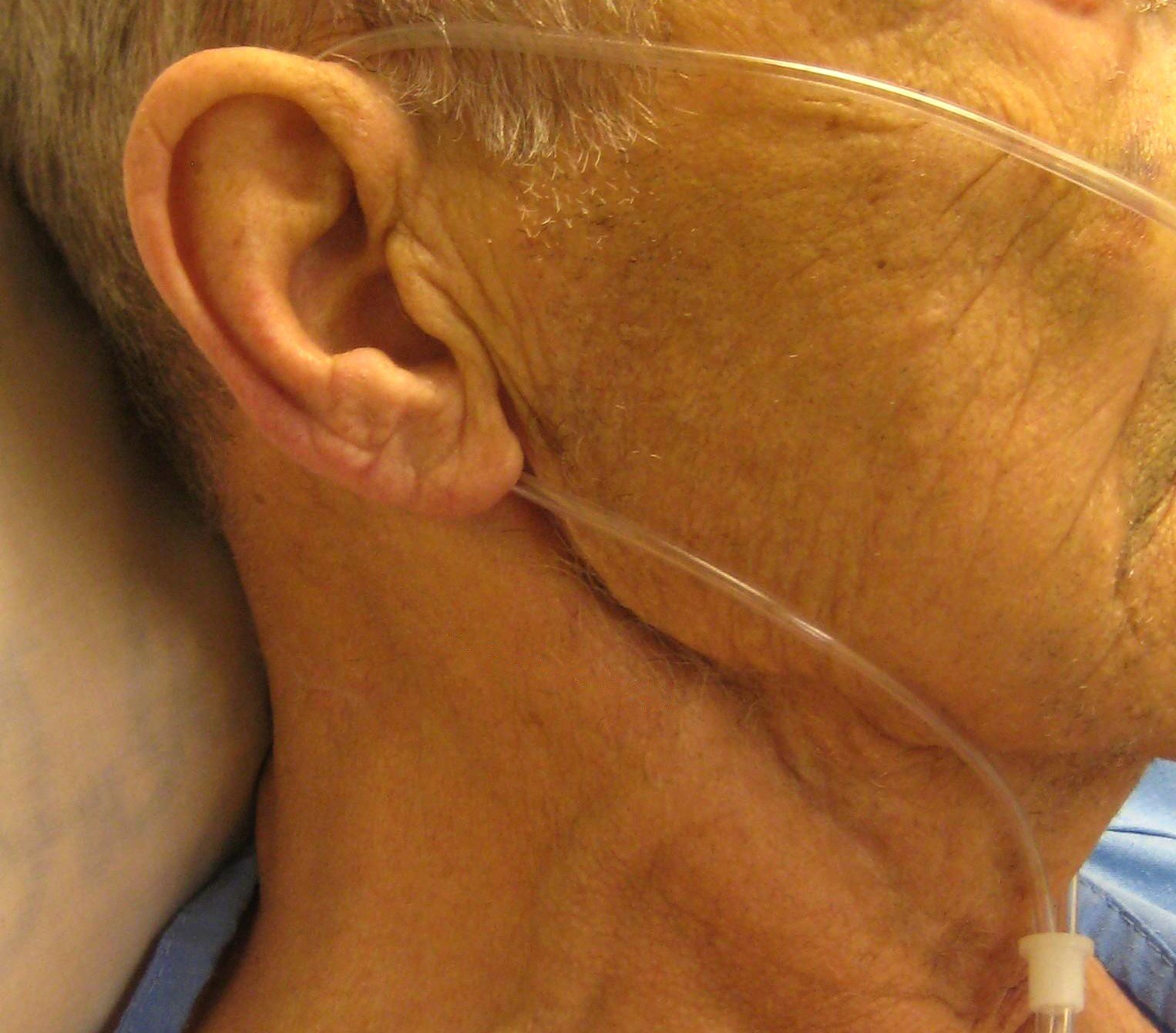
Ear pain and pressure is another extremely common problem that patients have with supplemental oxygen therapy. It happens because nasal cannulae are held up by looping over your ears, and the weight creates pressure that can be extremely uncomfortable. If you have to wear a nasal cannula every day for an extended period of time, it can be especially painful and difficult to manage.
Luckily, since it's such a common issue, there are several effective techniques and products available for reducing ear pain and discomfort with oxygen therapy. There are a variety of different types of padding, connectors, specialized nasal cannulae, and more that can make nasal cannulae much more comfort


 So we can find the best portable oxygen concentrator for your needs!
So we can find the best portable oxygen concentrator for your needs!





